Paul Finch's Blog, page 17
February 27, 2016
Mermaids, murderers and beers at the bar
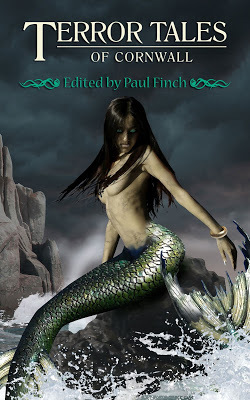 This is the new cover for the latest book in the Terror Tales series. As you can see, it will be TERROR TALES OF CORNWALL.
This is the new cover for the latest book in the Terror Tales series. As you can see, it will be TERROR TALES OF CORNWALL.The book isn't quite ready yet, so I can't post a direct link to it, or even give you a table of contents or a back-cover blurb. Suffice to say, it will be full of what you expect: roaring seas, jagged coasts, wild moors, lonely tin mines and isolated villages with curses on them. We've got witches, sea serpents, ghosts, faeries, sadistic killers, etc. As I say, it can't be unveiled just yet, but we're looking to publish sometime in late spring or early summer. In the meantime, enjoy the striking cover, provided as usual by the indefatigable Warrington-based artist, Neil Williams.
We've had more hi-jinks than usual with the cover this time. Initially, it was raunchier than usual in that the mermaid - predatory she-devil though she clearly is - was showing quite a bit of flesh. Most observers thought we should go with it anyway to try and capture the erotic allure of this ancient monster, but ultimately I bottled out. These books need wide exposure and we had it intimated to us that several websites might not be able to carry the image as they have a kind of unofficial 'no nipples' policy.
This is a slightly more chaste version. But I'm sure you'll agree, it's still pretty impressive.
(A quick note on the Terror Tales series, by the way. Gray Friar Press are currently between websites. They are constructing a brand new one, so at present there is no direct access to the Terror Tales books via the publisher. Sorry for any inconvenience this may cause, but if you are interested in buying or reading about them, please feel free to follow the links to the Amazon pages and other online retailers, where they can still be purchased. Again, as soon as the new site is up and ready, I'll post all the details here).
On a completely different note, at the end of this column today, I'll be reopening my Thrillers, Chillers, Shockers and Killers feature for 2016, and this week it will focus on Peter James's latest crime masterwork, YOU ARE DEAD . As usual with my book reviews, you will find that at the end of this post.
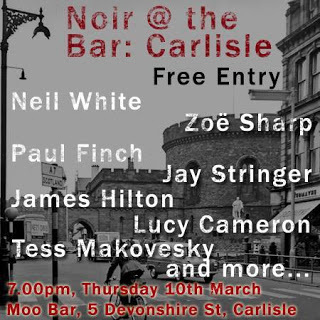 Still on the subject of crime fiction, if there's anyone up here in the North or on the Borders who fancies a face-to-face chat, I'll be appearing in NOIR AT THE BAR at the Moo Bar on Devonshire Street, Carlisle, at 7pm on Thursday March 10, alongside a bunch of famous crime-writers, including Neil White, Zoe Sharp, Jay Stringer, James Hilton, Lucy Cameron and Tess Makovesky. If you're in the area at the time, why not pop in for a pint and listen to us blather on?
Still on the subject of crime fiction, if there's anyone up here in the North or on the Borders who fancies a face-to-face chat, I'll be appearing in NOIR AT THE BAR at the Moo Bar on Devonshire Street, Carlisle, at 7pm on Thursday March 10, alongside a bunch of famous crime-writers, including Neil White, Zoe Sharp, Jay Stringer, James Hilton, Lucy Cameron and Tess Makovesky. If you're in the area at the time, why not pop in for a pint and listen to us blather on?And now, a small diversion. A few months ago, I was approached by Readers Digest, who were looking to do some promotion work for their annual 100-Word Short Story Competition. They asked if I would produce one of my own, a chilling tale of exactly 100 words, to include in the publicity material. I scribbled a few down, and one was duly accepted and went to press.
It follows below. But as a treat - I just know you guys love your treats - the other best four of the bunch I supplied (in my opinion) will follow on from it. Happy (if speedy) reading ...
“Darren,” Sue whispered, “there’s someone in the wardrobe.”“Go back to sleep,” he muttered. Her nervousness at night had always irritated him.“No. We must check. That lunatic who escaped from the asylum …”Grumpily, he climbed from the bed and fumbled his way across the darkened room. “For God’s sake, put the lights on,” he said over his shoulder.The bedside lamp came on as Darren yanked the wardrobe open – and choked in horror. Sue stood facing him, propped against the compartment’s wooden back, throat slit.“Is it anyone we know, darling?” came a singsong voice from the bed.
And now, as promised, the rest of them ...
When I went into the prison cell, it was awful. Tiny, dark and damp. The maniac, meanwhile, was waiting in its far corner, arms folded across his barrel chest.
“So you’re the doctor, are you?” he said.I nodded, immediately wary.He had a shaved bullet-head, eyes like chips of broken glass and the neck and shoulders of an ox. “You don’t like me already,” he said. “I can tell.”“I don’t know you yet,” I murmured.
"You soon will.” He grinned as he adjusted the cuffs on his prison officer uniform. “We don’t care for wife murderers in here.”
“It’s your fault, mum,” the vacant-faced young man told the weeping woman. “You’ve been saying for ages it’s time I took a girl out.”“Of course.” She glanced at the grim-faced policemen standing behind him. “You’re twenty-five. I was getting worried.”“Well that’s all I did.” He stood stiffly as they applied the handcuffs. “It was Jenny from work. We went for a pizza and then to the cinema.”“So what on Earth went wrong?” his mother sobbed.“Nothing.” He shook his head dumbly. “I drove her to the old railway bridge afterwards. And that’s where I took her out.”
The costume shop at the end of the dingy little back alley had always fascinated Miranda.“Your mannequins are so lifelike she told its thin-faced proprietor. “May I touch?”“Of course.”The wax was smooth and cool under her fingertips.He chuckled. “You must have believed those nasty rumours that I use dead bodies stuffed with straw?”Shamefaced, she couldn’t deny it. “Dead skin would never look as real as wax,” he added.Then she knocked the mannequin over, breaking it. She gasped.“On the other hand,” and he locked the shop door, “bones and internal organs do just fine.”
“It’s the Mutilator for sure,” the DI said, grey-faced as he stepped outside the forensic tent.The Police and Crime Commissioner’s heart sank. This madman had been terrorising the town for weeks now. “Are you absolutely certain?” she asked. “To be honest, I didn’t think there’d be a single body-part left that he hasn’t already collected.”“There isn’t,” the DI said, loosening his collar. “That’s why this one isn’t missing anything.”She felt a thrill of horror. “You don’t mean …?”“We knew he was good with a meat cleaver. Seems he’s also a dab-hand with a needle and thread.”
*
THRILLERS, CHILLERS, SHOCKERS AND KILLERS ...
A series of reviews of dark fiction (crime, thriller, horror and fantasy novels) – both old and new – that I have recently read and enjoyed. I’ll endeavour to keep the SPOILERS to a minimum; there will certainly be no given-away denouements or exposed twists-in-the-tail, but by the definition of the word ‘review’, I’m going to be talking about these books in more than just thumbnail detail, extolling the aspects that I particularly enjoyed … so I guess if you’d rather not know anything at all about these pieces of work in advance of reading them yourself, then these particular posts will not be your thing.
YOU ARE DEAD by Peter James (2015)
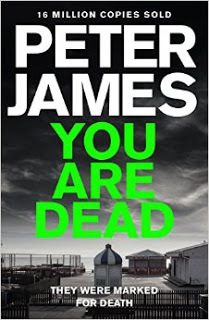
Detective Superintendent Roy Grace faces one of his toughest ever challenges when, in the midst of moving house one rainy Christmas, at the same time as having to bury and grieve for a beloved colleague, he finds himself with two very serious crimes on his desk: a young woman is abducted from the garage below the flats where she lives, while elsewhere in the city a body is uncovered by workmen – this too belonged to a young woman, though by the looks of it she was killed at least a couple of decades ago. Initially there is no obvious connection, but then another girl disappears, and another, and it dawns on Grace with more than a smattering of horror that he might be investigating Brighton’s first serial murder case in 80 years.
You’d think the ace investigator with the ultra-reliable and professional team would be well equipped to deal with this. But these are tough times for all involved, Grace in particular – because suddenly there is fresh information about his first wife, Sandy, who disappeared 10 years earlier and who, for a brief time at least, he was suspected of having murdered. This is more than a little bit distracting for him, but never let it be said that any maniac – no matter how sadistic or deranged – can get the drop easily on Roy Grace …
YOU ARE DEAD is the 11th outing for Peter James’s popular police hero, and for my money one of the best yet.
Grace is a hugely likable character. Not just a sharp and fearless detective, or the cool hand on the tiller of what is almost always a massive and complex police operation, but an everyman too – life gets in the way for him much as it does for the rest of us mere mortals, he has personal issues and professional issues, things aren’t always great either at home or in the office. As such, we completely empathise with him. (He also has a remarkably warm relationship with his goldfish, Marlon, which I find charming and amusing in equal measure). But despite all this, of course, the killers keep coming – and someone has to catch them. Yes indeed, the Roy Grace novels are a deadly serious business.
YOU ARE DEAD doesn’t just rattle along at the usual frenetic pace, hitting us with twists and curve-balls at every turn, working its way inevitably to another breakneck climax, but more so than almost any of the previous novels, it amply illustrates one of Peter James’s greatest trademarks – his astonishingly detailed research.
From the beginning with Grace, James set himself a difficult task, focussing on the SIO, the guy in command, and thus, with each book, needing to give us a constant and accurate overview of everything happening with the investigation. That would be a mammoth job even without the need to weave it into a fast and intriguing narrative. But James pulls it off in YOU ARE DEAD with his usual effortless aplomb. All the authenticity is there – you actually feel you’re in a real Incident Room, surrounded by the most up-do-date crime investigation technology, in company with coppers who look and sound like real coppers – and yet none of it is intrusive. James’s police protocols and procedures are bang-on, his understanding of even minor legalities is superb, his handling of police relationships as realistic as I’ve ever seen – yet this is background stuff; the narrative itself remains uncluttered, its pace relentless. Like all the others, this at heart is a very human story, one man determinedly pursuing an enemy of society with his wits and his courage, and risking life, limb and love in the process.
Another unforgettable entry in the Roy Grace canon. Absolutely terrific.
As I usually do, and purely for fun, here are my picks for who should play the leads if YOU ARE DEAD at some point makes it to the screen (there’s been talk for years about a TV series – which I personally would love to see, but I don’t think anything’s imminent, and even if it was, it obviously wouldn’t start with YOU ARE DEAD, so this one really is just for fun):
Detective Superintendent Roy Grace – Colin FirthCleo – Tamzin OuthwaiteACC Cassian Pewe – Aiden Gillen
Published on February 27, 2016 10:38
Mermaids, murderers and beer at the bar
 This is the new cover for the latest book in the Terror Tales series. As you can see, it will be TERROR TALES OF CORNWALL.
This is the new cover for the latest book in the Terror Tales series. As you can see, it will be TERROR TALES OF CORNWALL.The book isn't quite ready yet, so I can't post a direct link to it, or even give you a table of contents or a back-cover blurb. Suffice to say, it will be full of what you expect: roaring seas, jagged coasts, wild moors, lonely tin mines and isolated villages with curses on them. We've got witches, sea serpents, ghosts, faeries, sadistic killers, etc. As I say, it can't be unveiled just yet, but we're looking to publish sometime in late spring or early summer. In the meantime, enjoy the striking cover, provided as usual by the indefatigable Warrington-based artist, Neil Williams.
We've had more hi-jinks than usual with the cover this time. Initially, it was raunchier than usual in that the mermaid - predatory she-devil though she clearly is - was showing quite a bit of flesh. Most observers thought we should go with it anyway to try and capture the erotic allure of this ancient monster, but ultimately I bottled out. These books need wide exposure and we had it intimated to us that several websites might not be able to carry the image as they have a kind of unofficial 'no nipples' policy.
This is a slightly more chaste version. But I'm sure you'll agree, it's still pretty impressive.
(A quick note on the Terror Tales series, by the way. Gray Friar Press are currently between websites. They are constructing a brand new one, so at present there is no direct access to the Terror Tales books via the publisher. Sorry for any inconvenience this may cause, but if you are interested in buying or reading about them, please feel free to follow the links to the Amazon pages and other online retailers, where they can still be purchased. Again, as soon as the new site is up and ready, I'll post all the details here).
On a completely different note, at the end of this column today, I'll be reopening my Thrillers, Chillers, Shockers and Killers feature for 2016, and this week it will focus on Peter James's latest crime masterwork, YOU ARE DEAD . As usual with my book reviews, you will find that at the end of this post.
 Still on the subject of crime fiction, if there's anyone up here in the North or on the Borders who fancies a face-to-face chat, I'll be appearing in NOIR AT THE BAR at the Moo Bar on Devonshire Street, Carlisle, at 7pm on Thursday March 10, alongside a bunch of famous crime-writers, including Neil White, Zoe Sharp, Jay Stringer, James Hilton, Lucy Cameron and Tess Makovesky. If you're in the area at the time, why not pop in for a pint and listen to us blather on?
Still on the subject of crime fiction, if there's anyone up here in the North or on the Borders who fancies a face-to-face chat, I'll be appearing in NOIR AT THE BAR at the Moo Bar on Devonshire Street, Carlisle, at 7pm on Thursday March 10, alongside a bunch of famous crime-writers, including Neil White, Zoe Sharp, Jay Stringer, James Hilton, Lucy Cameron and Tess Makovesky. If you're in the area at the time, why not pop in for a pint and listen to us blather on?And now, a small diversion. A few months ago, I was approached by Readers Digest, who were looking to do some promotion work for their annual 100-Word Short Story Competition. They asked if I would produce one of my own, a chilling tale of exactly 100 words, to include in the publicity material. I scribbled a few down, and one was duly accepted and went to press.
It follows below. But as a treat - I just know you guys love your treats - the other best four of the bunch I supplied (in my opinion) will follow on from it. Happy (if speedy) reading ...
“Darren,” Sue whispered, “there’s someone in the wardrobe.”“Go back to sleep,” he muttered. Her nervousness at night had always irritated him.“No. We must check. That lunatic who escaped from the asylum …”Grumpily, he climbed from the bed and fumbled his way across the darkened room. “For God’s sake, put the lights on,” he said over his shoulder.The bedside lamp came on as Darren yanked the wardrobe open – and choked in horror. Sue stood facing him, propped against the compartment’s wooden back, throat slit.“Is it anyone we know, darling?” came a singsong voice from the bed.
And now, as promised, the rest of them ...
When I went into the prison cell, it was awful. Tiny, dark and damp. The maniac, meanwhile, was waiting in its far corner, arms folded across his barrel chest.
“So you’re the doctor, are you?” he said.I nodded, immediately wary.He had a shaved bullet-head, eyes like chips of broken glass and the neck and shoulders of an ox. “You don’t like me already,” he said. “I can tell.”“I don’t know you yet,” I murmured.
“You soon will.” He grinned as he adjusted the cuffs on his prison officer uniform. “We don’t care for wife murderers in here.”
“It’s your fault, mum,” the vacant-faced young man told the weeping woman. “You’ve been saying for ages it’s time I took a girl out.”“Of course.” She glanced at the grim-faced policemen standing behind him. “You’re twenty-five. I was getting worried.”“Well that’s all I did.” He stood stiffly as they applied the handcuffs. “It was Jenny from work. We went for a pizza and then to the cinema.”“So what on Earth went wrong?” his mother sobbed.“Nothing.” He shook his head dumbly. “I drove her to the old railway bridge afterwards. And that’s where I took her out.”
The costume shop at the end of the dingy little back alley had always fascinated Miranda.“Your mannequins are so lifelike she told its thin-faced proprietor. “May I touch?”“Of course.”The wax was smooth and cool under her fingertips.He chuckled. “You must have believed those nasty rumours that I use dead bodies stuffed with straw?”Shamefaced, she couldn’t deny it. “Dead skin would never look as real as wax,” he added.Then she knocked the mannequin over, breaking it. She gasped.“On the other hand,” and he locked the shop door, “bones and internal organs do just fine.”
“It’s the Mutilator for sure,” the DI said, grey-faced as he stepped outside the forensic tent.The Police and Crime Commissioner’s heart sank. This madman had been terrorising the town for weeks now. “Are you absolutely certain?” she asked. “To be honest, I didn’t think there’d be a single body-part left that he hasn’t already collected.”“There isn’t,” the DI said, loosening his collar. “That’s why this one isn’t missing anything.”She felt a thrill of horror. “You don’t mean …?”“We knew he was good with a meat cleaver. Seems he’s also a dab-hand with a needle and thread.”
*
THRILLERS, CHILLERS, SHOCKERS AND KILLERS ...
A series of reviews of dark fiction (crime, thriller, horror and fantasy novels) – both old and new – that I have recently read and enjoyed. I’ll endeavour to keep the SPOILERS to a minimum; there will certainly be no given-away denouements or exposed twists-in-the-tail, but by the definition of the word ‘review’, I’m going to be talking about these books in more than just thumbnail detail, extolling the aspects that I particularly enjoyed … so I guess if you’d rather not know anything at all about these pieces of work in advance of reading them yourself, then these particular posts will not be your thing.
YOU ARE DEAD by Peter James (2015)

Detective Superintendent Roy Grace faces one of his toughest ever challenges when, in the midst of moving house one rainy Christmas, at the same time as having to bury and grieve for a beloved colleague, he finds himself with two very serious crimes on his desk: a young woman is abducted from the garage below the flats where she lives, while elsewhere in the city a body is uncovered by workmen – this too belonged to a young woman, though by the looks of it she was killed at least a couple of decades ago. Initially there is no obvious connection, but then another girl disappears, and another, and it dawns on Grace with more than a smattering of horror that he might be investigating Brighton’s first serial murder case in 80 years.
You’d think the ace investigator with the ultra-reliable and professional team would be well equipped to deal with this. But these are tough times for all involved, Grace in particular – because suddenly there is fresh information about his first wife, Sandy, who disappeared 10 years earlier and who, for a brief time at least, he was suspected of having murdered. This is more than a little bit distracting for him, but never let it be said that any maniac – no matter how sadistic or deranged – can get the drop easily on Roy Grace …
YOU ARE DEAD is the 11th outing for Peter James’s popular police hero, and for my money one of the best yet.
Grace is a hugely likable character. Not just a sharp and fearless detective, or the cool hand on the tiller of what is almost always a massive and complex police operation, but an everyman too – life gets in the way for him much as it does for the rest of us mere mortals, he has personal issues and professional issues, things aren’t always great either at home or in the office. As such, we completely empathise with him. (He also has a remarkably warm relationship with his goldfish, Marlon, which I find charming and amusing in equal measure). But despite all this, of course, the killers keep coming – and someone has to catch them. Yes indeed, the Roy Grace novels are a deadly serious business.
YOU ARE DEAD doesn’t just rattle along at the usual frenetic pace, hitting us with twists and curve-balls at every turn, working its way inevitably to another breakneck climax, but more so than almost any of the previous novels, it amply illustrates one of Peter James’s greatest trademarks – his astonishingly detailed research.
From the beginning with Grace, James set himself a difficult task, focussing on the SIO, the guy in command, and thus, with each book, needing to give us a constant and accurate overview of everything happening with the investigation. That would be a mammoth job even without the need to weave it into a fast and intriguing narrative. But James pulls it off in YOU ARE DEAD with his usual effortless aplomb. All the authenticity is there – you actually feel you’re in a real Incident Room, surrounded by the most up-do-date crime investigation technology, in company with coppers who look and sound like real coppers – and yet none of it is intrusive. James’s police protocols and procedures are bang-on, his understanding of even minor legalities is superb, his handling of police relationships as realistic as I’ve ever seen – yet this is background stuff; the narrative itself remains uncluttered, its pace relentless. Like all the others, this at heart is a very human story, one man determinedly pursuing an enemy of society with his wits and his courage, and risking life, limb and love in the process.
Another unforgettable entry in the Roy Grace canon. Absolutely terrific.
As I usually do, and purely for fun, here are my picks for who should play the leads if YOU ARE DEAD at some point makes it to the screen (there’s been talk for years about a TV series – which I personally would love to see, but I don’t think anything’s imminent, and even if it was, it obviously wouldn’t start with YOU ARE DEAD, so this one really is just for fun):
Detective Superintendent Roy Grace – Colin FirthCleo – Tamzin OuthwaiteACC Cassian Pewe – Aiden Gillen
Published on February 27, 2016 10:38
January 14, 2016
Here's Lucy: a new cop on the mean streets
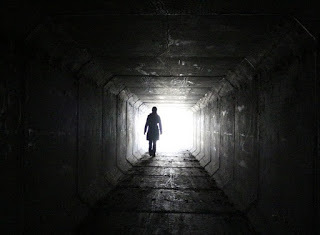 I've had to field quite a lot of questions recently about when the next Heck novel will be coming out, will there be any more in the series, and is it conceivable that
HUNTED
, the most recent Heck adventure to date, will be the final outing for the lone-wolf detective with the know-it-all attitude and the dogged determination to pursue his prey to the very ends of the Earth?
I've had to field quite a lot of questions recently about when the next Heck novel will be coming out, will there be any more in the series, and is it conceivable that
HUNTED
, the most recent Heck adventure to date, will be the final outing for the lone-wolf detective with the know-it-all attitude and the dogged determination to pursue his prey to the very ends of the Earth?Well, the short answer is ... no, it is nowhere near the end of the line for Heck. But it will be another year at least before there are any further Heck novels. And the explanation for that is relatively simple and hopefully non-too alarming.
I was writing Heck at a rate of two novels a year, and while it was fun it wasn't leaving me much time for anything else. On top of that, for quite a while I'd been wanting to pen something different.
One of the problems with writing the same characters all the time is that, despite your best efforts, you sometimes feel there's a danger it can get stale, a little samey. I don't think for one minute that this has happened with Heck, but I didn't want there to be even a danger that it might. So I had a conflab with the powers-that-be in Harper UK's incredible new home on the South Bank of the Thames, and we decided to give the Heck series a brief rest.
And when I say that, I mean it - a BRIEF rest, that's all. If it'll help soothe any nerves, the next Heck novel, THE BURNING MAN , is written and awaiting a few edits, and it can already be preordered. In the meantime, I decided I was going to have a crack at something else for Avon Books. Another thriller, obviously - as I rarely stray beyond the boundaries of dark fiction - but centred around a different set of characters and circumstances.
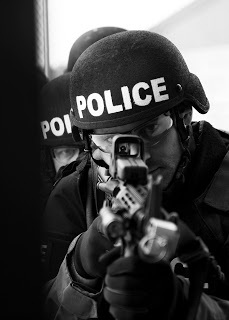 Most of my readers will know that the Heck novels are based at Scotland Yard, where the National Crime Group's most specialised division, the Serial Crimes Unit (of which Heck is a detective sergeant), embroils itself in a relentless hunt for Britain's serial killers. It is high-level crime-fighting by a bunch of people who have all the modern police's most sophisticated techniques and facilities immediately to hand.
Most of my readers will know that the Heck novels are based at Scotland Yard, where the National Crime Group's most specialised division, the Serial Crimes Unit (of which Heck is a detective sergeant), embroils itself in a relentless hunt for Britain's serial killers. It is high-level crime-fighting by a bunch of people who have all the modern police's most sophisticated techniques and facilities immediately to hand.But in the new novel, I fancied toning things down a little - going back to Division in fact, where more down-to-Earth kinds of coppers also walk a tightrope in the world of crime, but with less hi-tech backup and at the same time having also to deal with the grimy fall-out of it: the drunkenness and drug-addiction; the ruined lives; the desolate, vomit-covered streets; the brutalised, terrorised citizens.
I also wanted to revisit a character who first appeared, believe it or not, in a television drama I wrote back in 1993 called NO FURY (aka DIRTY WORK). Though that script was optioned several times, and a fairly well-known British TV actress expressed strong interest in it, it was never actually filmed and in due course all the rights reverted to me. The character in question was a certain LUCY CLAYBURN, a young but feisty uniformed constable in the Greater Manchester Police, who is very self-conscious that her family come from the wrong side of the tracks but determined all the same to make a big splash in this most difficult and macho of professions.
At the time of NO FURY, Lucy is already an effective copper with a good working-knowledge of her beat and the various villains and vulnerables who live on it, but what she really wants to do is join CID and start chasing the higher league criminals, the detritus of whose activities make life for everyone else so difficult. Don't be worried about encountering any spoilers here, by the way. NO FURY is long dead; monstrously dated, with big chunks of its original story subsequently cannibalised for other projects. The only survivor from it now is Lucy herself, and in the new novel in which she stars, she goes on to follow a very different path from the one I originally envisaged.
The novel is to be called STRANGERS , and I've just completed - as in this very morning - the first draft of it. All being well, I can announce that it will be published in summer this year. Again, there'll be no spoilers here, but I don't think anyone will mind if I give this much away ...
At the start of STRANGERS , Lucy is ten years in the job. She's an excellent uniformed copper, having spent all her service working the mean streets of Crowley, a run-down, largely unemployed Manchester borough sandwiched between Salford and Bolton. But she is still young and still has ambitions to join CID, the opportunity for which finally comes when a series of extremely horrific murders commences in the district, and the call goes out for young policewomen who don't mind getting their hands dirty to accept various, risky undercover assignments.
 Naturally, Lucy volunteers - only to find herself near enough marooned in a dangerous and sordid world of prostitutes, pimps, drug addicts, general purpose sleazeballs, and of course, gangsters.
Naturally, Lucy volunteers - only to find herself near enough marooned in a dangerous and sordid world of prostitutes, pimps, drug addicts, general purpose sleazeballs, and of course, gangsters.From this point on, those who enjoy the Heck novels will probably know what to expect.
I'm an ex-copper and newspaper reporter, so I try not to pull punches when dealing with this kind of subject-matter. STRANGERS comes to us from a very dark and dingy place, where the gutters run with filth, there is always blood in the bus station toilets and syringes litter the back alleyways. I make no apologies for any of that, nor for presenting violent crime the way it is: brutish weaponry, savage beatings, horrible injuries, and a plethora of gleefully twisted, depraved and downright certifiable villains, the sort who get no pleasure in life unless they are hurting others.
 Another inheritance from Heck is the action. Sorry if there are folk out there who prefer the armchair approach to criminal investigation, but that isn't me - nor is it Heck, nor Lucy Clayburn.
Another inheritance from Heck is the action. Sorry if there are folk out there who prefer the armchair approach to criminal investigation, but that isn't me - nor is it Heck, nor Lucy Clayburn.Lucy isn't Wonderwoman, but she's kicked more than a few doors down in her time and chased plenty of bad guys hell-for-leather across the city in her police car. That was how I always conceived her, and that's exactly how it is in this new book. Of course, it's going to be a slightly differerent experience from Heck in that Lucy is a woman, and if she wants to come out on top when there are hoodlums to be collared, she's going to have to use at least as much guile as brawn.
Anyway, I've said enough.
Hopefully I've now put everyone in the picture about where we stand with Heck. Watch out for THE BURNING MAN in 2017, but also for STRANGERS featuring Lucy Clayburn, the action/cop heroine who'll be introducing herself to you this year, and who, if everything goes well - and this is really up to you guys, I suppose - could well be embarking on what may be a whole new series of high-octane investigations.
(The top image and the bottom two come to us courtesy of Pixabay. The armed cop is by John Crosby).
Published on January 14, 2016 09:47
January 1, 2016
Blood, foam, fury - terror on the high seas
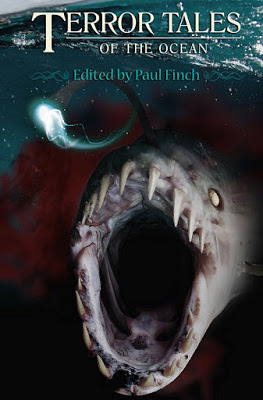 It gives me great pleasure to see in the New Year by officially announcing volume nine in the
TERROR TALES
series I edit for
GRAY FRIAR PRESS
:
TERROR TALES OF THE OCEAN
.
It gives me great pleasure to see in the New Year by officially announcing volume nine in the
TERROR TALES
series I edit for
GRAY FRIAR PRESS
:
TERROR TALES OF THE OCEAN
.Yep, it's done and dusted at last, and you can order it right now from either the publisher's site, or from AMAZON .
The original idea behind this anthology series was to do a round-tour of the British Isles, publishing brand new scary fiction from a range of top-drawer writers, each book interspersing these works of fiction with true tales of terror relating to each region under examination.
However, nine volumes in, we've got around the UK at a rate of knots, and though there are several British locations still to visit, it was probably inevitable that gradually we were going to start looking farther afield, and to a certain extent this new volume is the first one of that ilk. In a nutshell, this time around I gave my writers free rein - they could look at any sea or ocean on Earth, not just those washing along the shores of the UK, and I told them to go over them, under them and all along their edges.
As you can imagine, there was considerable potential here for some truly chilling horror stories, and as you're about to find out - if you buy! - none of the lads and lassest disappointed. But ... as always, it's now time for me to shut my mouth and let the book do the talking. Here's the official front cover artwork (courtesy of the near-superhuman Neil Williams) and the back-cover blurb. Below that sits the full table of contents, and under that a few choice excerpts to hopefully whet your whistles for the greater terrors to come:
The rolling blue ocean. Timeless, vast, ancient, mysterious. Where eerie voices call through the lightless deeps, monstrous shapes skim beneath the waves, and legends tell of sunken cities, fiendish fogs, ships steered only by dead men, and forgotten isles where abominations lurk …
The multi-limbed horror in the Ross SeaThe hideous curse of Palmyra AtollThe murderous duo of the Messina StraitThe doomed crew of the Flying DutchmanThe devil fish of the South PacificThe alien creatures in the English ChannelThe giant predator of the Mariana Trench
And many more chilling tales by Peter James, Adam Nevill, Stephen Laws, Lynda E. Rucker, Conrad Williams, Robert Shearman and other award-winning masters and mistresses of the macabre.
TABLE OF CONTENTS
Stuka Juice by Terry Grimwood
Ship of the Dead
The End of the Pier by Stephen Laws
The Swirling Sea
Lie Still, Sleep Becalmed by Steve Duffy
Meg
The Seventh Wave by Lynda E. Rucker
The Palmyra Curse
Hippocampus by Adam Nevill
Gelatinous
The Offing by Conrad Williams
Blood and Oil
Sun Over the Yard Arm by Peter James
Echoes of an Eldritch Past
First Miranda by Simon Strantzas
Sharkbait
The Derelict of Death by Simon Clark and John B. Ford
Horrific Beasts
The Decks Below by Jan Edwards
The Flying Dutchman
Hell in the Cathedral by Paul Finch
From the Hadean Deep
Hushed Will Be All Murmurs by Adam Golaski
Mer-Killers
And This Is Where We Falter by Robert Shearman
It is William Bates who is at the stern and spies something strange in the seas behind us. What is that? he says. I say I do not know, it looks like a black spot upon the surface of the water. I am sure that we will lose sight of it soon, fast as we are now speeding, but an hour later we think to look back, and there it still is - it is larger, if anything, it is ganing on us. It is in pursuit. How it bobs about on the waves.
Before sunset it is close enough that we can identify it, and it is a coffin ...
And This Is Where We Falter Robert Shearman
Cold water arced across her face like a slap, returning her to her senses; and to a roughly humanoid shape framed in the doorway.
Its arms seemed too long, with webbed hands clutching the hatch edge. Its legs were bowed and short. A ridge of bone rose across its skull, which was narrow, with eyes set more to the sides than was human. The mouth was wide, with a pronounced peak to a thin upper lip, giving a beak-like appearance ...
The Decks Below Jan Edwards
Feeling lighter now as the buoyancy supported the weight of the suit, I made a half-turn on my platform so I could see the keel of the ship and maybe discern what held her in place. I waited for a gush of bubbles to pass so I could get the whole picutre. But what I then saw sent sheets of ice through me. I pushed my face forward against the glass plate, my eyes bulging, my heart thudding.
Gripping the bottom of the ship like a massive sucker was an amorphous piece of flesh, Pulpy and white, it was; almost the shape of a wine glass, its wide mouth clamped onto the keel as if the creature sucked at the timbers. Beneath that, it became fluted, growing narrower and narrower until a stem little thicker than my own waist ran down into the deeps ...
The Derelict of Death Simon Clark and John B. Ford
*

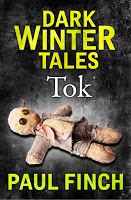 And now a quick and personal, though not completely unrelated thing, if you don't mind. Just a reminder that Avon Books at HarperCollins, who publish my Heck crime novels, have started raiding my own back catalogue of horror stories and putting them out (for the first time ever) as ebooks - as both a single collection,
DARK WINTER TALES
, or individually, as per this, one of my favourite supernatural thriller stories,
TOK
, (though there are plenty of other titles to choose from too).
And now a quick and personal, though not completely unrelated thing, if you don't mind. Just a reminder that Avon Books at HarperCollins, who publish my Heck crime novels, have started raiding my own back catalogue of horror stories and putting them out (for the first time ever) as ebooks - as both a single collection,
DARK WINTER TALES
, or individually, as per this, one of my favourite supernatural thriller stories,
TOK
, (though there are plenty of other titles to choose from too).If you're interested, just scroll down to the previous post on this blog, and you'll find all the details.
Published on January 01, 2016 07:04
December 22, 2015
Darkest part of the winter is still to come
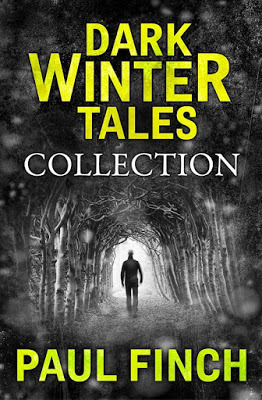 In an effort to continue the spooky traditions we hold so close to our hearts at this dreary time of year (and hell, just how dreary can it get in terms of damp, dismal weather!), I have a few new e-book titles out in mid-January, and now, with the Christmas revelries very soon behind us, might be an opportune time to mention them.
In an effort to continue the spooky traditions we hold so close to our hearts at this dreary time of year (and hell, just how dreary can it get in terms of damp, dismal weather!), I have a few new e-book titles out in mid-January, and now, with the Christmas revelries very soon behind us, might be an opportune time to mention them.Let’s face it, Yuletide will imminently be done and dusted – short and sweet as ever – but winter isn’t going anywhere for at least another two months, so we might as well make the gloom work for us by filling it with ghosts, demons, monsters and psychotic killers, eh?
I may have mentioned at some point before that Avon Books, who publish my Heck novels, have been looking for some time to raid my back-catalogue of horror and thriller stories, with a view to relaunching those they really like on the e-market.
Well, the first batch of seven has now been chosen, and here they are, complete with blurbs, cover-art and brief (hopefully juicy) extracts. DARK WINTER TALES is the collective title, and the e-book in which all seven stories are bundled together, but for those who prefer quick, one-off reads, they are also available individually.
THE INCIDENT AT NORTH SHORE : A lone policewoman seeks a clandestine meeting with her lover in a derelict amusement park on the same night that a mass-murdering maniac escapes from the local asylum …
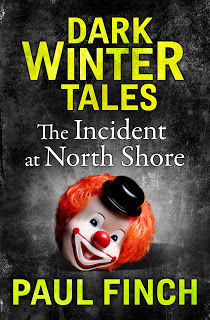 It comprised a row of clown heads and torsos – minus limbs – mounted on metal poles, each with a gaping mouth to serve as a target. Contestants stood behind a counter and pelted them with hard wooden balls, the idea being to get as many as you could through the open mouth of your particular clown and down into its belly. With each clean hit, the eyes would light up to the accompaniment of bells, whistles and hysterical ‘Daffy Duck’ giggles. Sharon had thought it an odd-looking thing even back then; she’d never been able to shake off an impression that the dummy clowns were screaming – and even now as she walked past the row of de-limbed figures, still sitting motionless under their canvas awning, she fancied their ink-black eyes were following her.
It comprised a row of clown heads and torsos – minus limbs – mounted on metal poles, each with a gaping mouth to serve as a target. Contestants stood behind a counter and pelted them with hard wooden balls, the idea being to get as many as you could through the open mouth of your particular clown and down into its belly. With each clean hit, the eyes would light up to the accompaniment of bells, whistles and hysterical ‘Daffy Duck’ giggles. Sharon had thought it an odd-looking thing even back then; she’d never been able to shake off an impression that the dummy clowns were screaming – and even now as she walked past the row of de-limbed figures, still sitting motionless under their canvas awning, she fancied their ink-black eyes were following her.TOK : A young woman is forced to stay with her semi-deranged mother-in-law in a musty old house on the outskirts of a town ravaged by a mysterious strangler who seems able to gain access to homes through the tiniest of gaps …
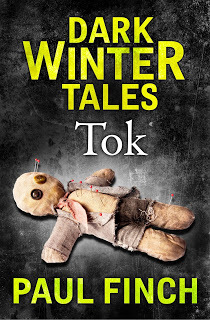 After they’d hacked and slashed the two bodies for several minutes, they danced on them. The firelight of a dozen torches glittered on their wild, rolling eyes, on their upraised blades, on the blood spattered liberally across the carpet of smoothly mown grass. Their shouts of delight filled the seething night. But when the little girl came out and stood on the veranda, there was a silence like a thunderclap. For a moment she seemed too pure to be in the midst of such mayhem, too angelic – a white-as-snow cherub, who, for all her tears and soiled nightclothes, brought a chill to the muggy forest by her mere presence, brought a hush to the yammering insects, brought the frenzied rage out of her captors like poison from a wound. If it wasn’t the little girl herself, it was the thing she held by her side. The thing they knew about by instinct.The thing they’d seen only in nightmares.
After they’d hacked and slashed the two bodies for several minutes, they danced on them. The firelight of a dozen torches glittered on their wild, rolling eyes, on their upraised blades, on the blood spattered liberally across the carpet of smoothly mown grass. Their shouts of delight filled the seething night. But when the little girl came out and stood on the veranda, there was a silence like a thunderclap. For a moment she seemed too pure to be in the midst of such mayhem, too angelic – a white-as-snow cherub, who, for all her tears and soiled nightclothes, brought a chill to the muggy forest by her mere presence, brought a hush to the yammering insects, brought the frenzied rage out of her captors like poison from a wound. If it wasn’t the little girl herself, it was the thing she held by her side. The thing they knew about by instinct.The thing they’d seen only in nightmares.GOD’S FIST : A traumatised ex-cop allows the pain and injustice of modern life to explode in his mind, and sets out on a vigilante rampage to punish those he deems personally responsible – but who is he to judge and how does he choose?
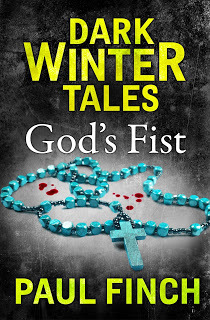 For once though, he didn’t settle down in bed with a Jack Higgins or Robert Ludlum; he settled down with three glossy black-and-white photographs. He looked at them again, hard, letting his mind wander. There were so many injustices in the world that just putting a tiny proportion of them right seemed beyond the combined powers of all the human agencies set up to serve the cause of good. There were so many instances in his own personal experience. More than once, he’d dragged the bloated, rot-riddled corpses of OD victims out from foul, flooded storm-drains, knowing full well that nobody would ever be blamed let alone prosecuted. One freezing winter, he’d broken into an old lady’s home to find the occupant on the kitchen floor, encased in ice; it was anyone’s guess how long she’d been there – only her failure to return library books had finally aroused interest. Then there’d been the turf war where several teen hoodlums had hauled a rival gangbanger up to the top floor of an eight-storey block, thrown him off, and when they’d come out at the bottom and found him still alive, had dragged him back up and done it again. That last incident had occurred in this very neighbourhood, Bagley End. Not surprisingly, no-one had ever been arrested for it, because nobody round Bagley End ever saw or heard anything.
For once though, he didn’t settle down in bed with a Jack Higgins or Robert Ludlum; he settled down with three glossy black-and-white photographs. He looked at them again, hard, letting his mind wander. There were so many injustices in the world that just putting a tiny proportion of them right seemed beyond the combined powers of all the human agencies set up to serve the cause of good. There were so many instances in his own personal experience. More than once, he’d dragged the bloated, rot-riddled corpses of OD victims out from foul, flooded storm-drains, knowing full well that nobody would ever be blamed let alone prosecuted. One freezing winter, he’d broken into an old lady’s home to find the occupant on the kitchen floor, encased in ice; it was anyone’s guess how long she’d been there – only her failure to return library books had finally aroused interest. Then there’d been the turf war where several teen hoodlums had hauled a rival gangbanger up to the top floor of an eight-storey block, thrown him off, and when they’d come out at the bottom and found him still alive, had dragged him back up and done it again. That last incident had occurred in this very neighbourhood, Bagley End. Not surprisingly, no-one had ever been arrested for it, because nobody round Bagley End ever saw or heard anything.WHAT’S BEHIND YOU?: A chirpy band of 1960s students head to a coastal village in Wales, where a nearby ruin is allegedly haunted by a ghost that creeps up from behind and whispers ‘What’s behind you?’ On no account must you ever look …
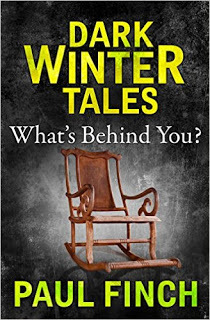 Bare boards lay where there had once been a carpet, and the paper on the walls hung only in strips as if someone had been vigorously rending at it; looking closely, the few strips remaining appeared to have been shredded by the claws of an animal. But my biggest shock came after my eyes had attuned properly to the dimness, and I turned to the large fireplace and noted a bath-chair to one side – with what looked like a figure reposed in it. The impression was so lifelike that I almost turned and fled, though somehow I resisted this and edged a little closer, eyes goggling – before it struck me that the chair contained nothing but a bundle of blankets. Even then I wasn’t completely put at ease. The blankets, which were exceedingly old and dirty, had been dumped in the bath-chair rather than folded and placed there neatly. As such, the corner of one musty old quilt had risen up at the point where a human head would be and drooped forward a little, creating what looked like a peaked hood. It was difficult to believe there’d be sufficient space under there to conceal a human. But even so, I found myself crouching and peeking warily in, half expecting to see some hideous, mouldering visage. Strangely, the empty hollow I saw instead was even more unsettling.
Bare boards lay where there had once been a carpet, and the paper on the walls hung only in strips as if someone had been vigorously rending at it; looking closely, the few strips remaining appeared to have been shredded by the claws of an animal. But my biggest shock came after my eyes had attuned properly to the dimness, and I turned to the large fireplace and noted a bath-chair to one side – with what looked like a figure reposed in it. The impression was so lifelike that I almost turned and fled, though somehow I resisted this and edged a little closer, eyes goggling – before it struck me that the chair contained nothing but a bundle of blankets. Even then I wasn’t completely put at ease. The blankets, which were exceedingly old and dirty, had been dumped in the bath-chair rather than folded and placed there neatly. As such, the corner of one musty old quilt had risen up at the point where a human head would be and drooped forward a little, creating what looked like a peaked hood. It was difficult to believe there’d be sufficient space under there to conceal a human. But even so, I found myself crouching and peeking warily in, half expecting to see some hideous, mouldering visage. Strangely, the empty hollow I saw instead was even more unsettling.THOSE THEY LEFT BEHIND : The elderly and embittered mother of the last man hanged exists in a world of her own. Her son’s crime was a hideous one, but she misses him terribly. Then, one day she acquires a former hangman’s dummy, and it looks strangely familiar …
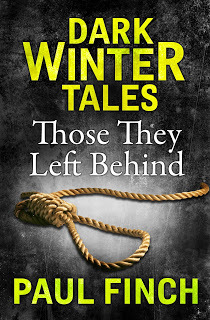 He retrieved the head from the shelf, and only now did Elsie notice that, from the neck down, it was attached to what looked like several folds of material – a thick canvas, which might once have been white but was now a dingy yellow. The stallholder shook the material out, and Elsie was shocked to see that it was body-shaped, comprising a broad torso with arms and legs stitched onto it, the proportions roughly accurate to an average-sized man. When he turned it around, she saw that, down its back there were zip-fasteners, one to each limb and one bisecting the middle of its trunk. “This is where they used to put the sand in,” the stallholder said. “Or the sawdust, depending on what they had available.”“I don’t understand,” Elsie replied.“No, didn’t think you did. Look …” Again, he shook out the material. “Hollow, see? And they used to put sand or sawdust in it. A different amount each time, to get the weight right.”“The weight?”“Only for practise, of course.”He offered to hand the head over to her. Elsie recoiled, though her gaze remained fixed on the faded, mournful face. The stallholder laughed. “I hope the hangman wasn’t as squeamish as you. Otherwise he’d never get to test his apparatus, would he?” Slowly, Elsie turned to look at him.He explained. “Old Bob here – that’s what they used to call him – Old Bob got dropped the day before each execution so they could see everything was working right.”
He retrieved the head from the shelf, and only now did Elsie notice that, from the neck down, it was attached to what looked like several folds of material – a thick canvas, which might once have been white but was now a dingy yellow. The stallholder shook the material out, and Elsie was shocked to see that it was body-shaped, comprising a broad torso with arms and legs stitched onto it, the proportions roughly accurate to an average-sized man. When he turned it around, she saw that, down its back there were zip-fasteners, one to each limb and one bisecting the middle of its trunk. “This is where they used to put the sand in,” the stallholder said. “Or the sawdust, depending on what they had available.”“I don’t understand,” Elsie replied.“No, didn’t think you did. Look …” Again, he shook out the material. “Hollow, see? And they used to put sand or sawdust in it. A different amount each time, to get the weight right.”“The weight?”“Only for practise, of course.”He offered to hand the head over to her. Elsie recoiled, though her gaze remained fixed on the faded, mournful face. The stallholder laughed. “I hope the hangman wasn’t as squeamish as you. Otherwise he’d never get to test his apparatus, would he?” Slowly, Elsie turned to look at him.He explained. “Old Bob here – that’s what they used to call him – Old Bob got dropped the day before each execution so they could see everything was working right.”HAG FOLD follows the parallel lives of two badly disturbed individuals: a slum kid turned ultra-violent cop and a savage and relentless serial killer. Steadily, day by day, fate draws them closer and closer together …
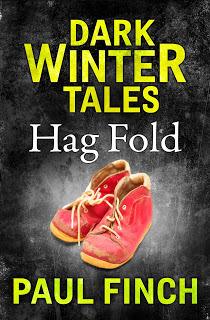 I forced entry, expecting the worst. What I found was worse than the worst. I gained access by smashing a ground-floor window, but the stench hit me like a sledgehammer as I climbed over the sill. It wasn’t just putrefaction – it was shit as well, vomit, flyblown offal. I’d been in the job several years by this time and had learned to prepare for all eventualities, so I stuffed pieces of cotton wool into my nostrils from the wad I always carried, and was able to continue.I’d expected a shrunken, mummified thing slumped in an armchair or curled up in some downstairs bed. That was the way you usually found them. Not this time. The lounge looked like a bomb had hit it. Smashed crockery, torn newspapers and shredded upholstery strewed the dirt-clogged carpet. Every item of furniture was overturned, and in the middle of it all lay the old fella, or what was left of him. He’d been laid bare to the bones. A few scraps of skin and chunks of gristle remained, but virtually all the soft tissue had gone, apart from a couple of lumpy black objects, which I later found out were diseased organs. Even the skull had been cracked open and the brain dug out. Stiff brown bloodstains caked everything.At first I thought I was looking at the scene of some bizarre ritual killing, and for a second I wanted to go and beat fifty colours out of the junkie next door. Then I heard the snarling – and it all became clear.
I forced entry, expecting the worst. What I found was worse than the worst. I gained access by smashing a ground-floor window, but the stench hit me like a sledgehammer as I climbed over the sill. It wasn’t just putrefaction – it was shit as well, vomit, flyblown offal. I’d been in the job several years by this time and had learned to prepare for all eventualities, so I stuffed pieces of cotton wool into my nostrils from the wad I always carried, and was able to continue.I’d expected a shrunken, mummified thing slumped in an armchair or curled up in some downstairs bed. That was the way you usually found them. Not this time. The lounge looked like a bomb had hit it. Smashed crockery, torn newspapers and shredded upholstery strewed the dirt-clogged carpet. Every item of furniture was overturned, and in the middle of it all lay the old fella, or what was left of him. He’d been laid bare to the bones. A few scraps of skin and chunks of gristle remained, but virtually all the soft tissue had gone, apart from a couple of lumpy black objects, which I later found out were diseased organs. Even the skull had been cracked open and the brain dug out. Stiff brown bloodstains caked everything.At first I thought I was looking at the scene of some bizarre ritual killing, and for a second I wanted to go and beat fifty colours out of the junkie next door. Then I heard the snarling – and it all became clear.CHILDREN DON’T PLAY HERE ANYMORE : A long-retired detective returns again and again to the scene of the only murder he wasn’t able to solve, increasingly and horribly worried that he’s worked out who the killer was …
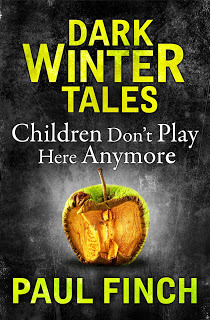 It was his eleventh birthday, and young Andrew had gone down to the Dell to see if any of his pals were around. That was all anyone really knew about it. His body was discovered seven hours later, under a bush and covered with leaves. He’d been bludgeoned to death with a brick, then sexually interfered-with. We made fingertip searches through those woods for the next three weeks, ran door-to-doors throughout the district, questioned every ‘possible’ in the town, and their families – over and over again. But to no avail. This happened in 1975, still nine years before the first DNA breakthroughs would be made, but even if we’d had that level of crime-busting technology available, it’s unlikely we’d have made progress. The killer was either too clever or too lucky. There was minimal evidence to go on. The murder weapon, which we recovered, had been thrown into the pond and thus was washed clean of fingerprints; it had been a dry summer day – the ground firm, the turf lush and springy, which meant there were no footprints; nobody living in the nearest houses had seen or heard anything untoward; public appeals for information drew a blank. No-one, it seemed, knew a damn thing.
It was his eleventh birthday, and young Andrew had gone down to the Dell to see if any of his pals were around. That was all anyone really knew about it. His body was discovered seven hours later, under a bush and covered with leaves. He’d been bludgeoned to death with a brick, then sexually interfered-with. We made fingertip searches through those woods for the next three weeks, ran door-to-doors throughout the district, questioned every ‘possible’ in the town, and their families – over and over again. But to no avail. This happened in 1975, still nine years before the first DNA breakthroughs would be made, but even if we’d had that level of crime-busting technology available, it’s unlikely we’d have made progress. The killer was either too clever or too lucky. There was minimal evidence to go on. The murder weapon, which we recovered, had been thrown into the pond and thus was washed clean of fingerprints; it had been a dry summer day – the ground firm, the turf lush and springy, which meant there were no footprints; nobody living in the nearest houses had seen or heard anything untoward; public appeals for information drew a blank. No-one, it seemed, knew a damn thing.
Published on December 22, 2015 09:05
December 8, 2015
The flipside of everything sweet and kind
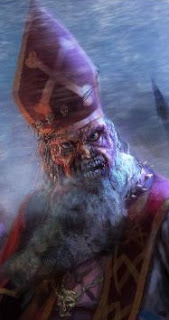 Okay, it's THAT time of year again. Or at least, it will be in a few days. Mince pies, crackers, glimmering glass baubles and snow-decked evergreens. But there are several alarming things about Christmas. Firstly, that it comes around so often. When I was a youngster, it seemed to take forever to arrive. Now that I'm in my 50s, festive seasons flicker by like speeded-up cine film. Secondly, that it's become such a non-meaningful feast. I'm not going to lecture anyone on this, but I despair at the amount of commercialisation that goes on at this time of year, seemingly minus any kind of understanding about the soul of Christmas (I mean, even our pagan ancestors knew that midwinter had a power and spirit all of its own). And thirdly, and this is the one where I'm both alarmed and excited at the same time, it's our penchant at this time of year for scary stories.
Okay, it's THAT time of year again. Or at least, it will be in a few days. Mince pies, crackers, glimmering glass baubles and snow-decked evergreens. But there are several alarming things about Christmas. Firstly, that it comes around so often. When I was a youngster, it seemed to take forever to arrive. Now that I'm in my 50s, festive seasons flicker by like speeded-up cine film. Secondly, that it's become such a non-meaningful feast. I'm not going to lecture anyone on this, but I despair at the amount of commercialisation that goes on at this time of year, seemingly minus any kind of understanding about the soul of Christmas (I mean, even our pagan ancestors knew that midwinter had a power and spirit all of its own). And thirdly, and this is the one where I'm both alarmed and excited at the same time, it's our penchant at this time of year for scary stories.Those who follow this column will know that each year about this time I post one of my own Christmas spook tales right here.Why is that? I don't know for sure, but I wouldn't do it if there wasn't a demand for it. And let's be honest, I'm only following in a grand old tradition.
Who knows what the origins of this are. Why do we enjoy our Christmas ghost stories so much? Possibly it's the fact that winter has closed in and the sun only sheds daylight on our frozen, desolate world for a few hours each day. Or is it just that we're unconsciously aware of the many ancient, pre-Christian customs that are woven into this event - the use of holly and mistletoe, the presence of elves, the conflation of the benign St. Nicholas with the darker druidic figure of Old Father Winter? Could it be that there's something genuinely magical and, dare I say it, supernatural, about Christmas that somehow afflicts all of us? I mean, what other religious festival of the year is partaken in as enthusiastically by so many atheists?
Either way, even if all that is guff, I'm still content to be doing what so many other writers do at this time of year. Ever since Charles Dickens penned A CHRISTMAS CAROL, other maestros of the written word have followed suite. M.R. James obviously - I mean come on (he all but invented the modern Christmas ghost story)! While Ramsey Campbell has made several astonishing contributions to the pantheon of festive fright fare, not least THE CHIMNEY and THE DECORATIONS. Robert Bloch did it with THE NIGHT BEFORE CHRISTMAS, L.P. Hartley with SOMEONE IN THE LIFT, Mary Danby with NURSERY TEA, Charles Birkin with KING OF THE CASTLE.
Compared to these momentous efforts, I feel my own tales may pale by comparison, but hey, I'm more than prepared to let you guys make that judgement for yourself. So here's this year's offering. It's called KRAMPUS, and before anyone complains about that, it was written and published yonks before the new movie of the same name. To be factual, it was first published in the online genre magazine, K-ZINE in the autumn of 2014, and now here it is again, entirely at your disposal:
KRAMPUS
Grandpa Ludwig didn’t usually participate on Christmas Day when we all gathered around the fire after dinner and urged the adults to tell ghost stories. Part of the time it was because he was asleep, but also, I think, it was because he didn’t enjoy such things. We all knew he’d had a difficult time as a child. It’s not everyone who can boast that his father was condemned in absentia to die by the guillotine, even if he did live to tell the tale, but Grandpa Ludwig was of such an age by this time – seventy-five at least – that he surely had no real memories of those dark and deadly days. In addition, his father had been a great storyteller, an author of children’s fiction as famous in Germany at one time as Enid Blyton was in England, so it hardly seemed possible that Grandpa Ludwig had not inherited at least a smidgen of that talent. As such, one year, when it was plain that Grandpa Ludwig was wide awake after dinner, laughing uproariously with the other adults, mince pie in hand, paper crown perched at a jaunty angle on his balding pate, we urged him to start off the annual ghost story game by telling us one of his own. Grandpa was very thoughtful for a moment or two. He took a sip of port wine, before nodding gravely and saying that, yes, it was time he told us all his ghost story. His choice of phrase quite surprised me. The notion that, all along, he’d possessed a ghost story that was exclusively his own, and that for so many years he’d been withholding it – who knew for what reason? – was an eerie and mysterious concept. I remember how we youngsters huddled together on the carpet in front of the fire, legs crossed, and how my mum turned the lights down, as she always did on this occasion, leaving only the faint glow of the candles on the Christmas cake and the orange embers in the hearth to reflect our rapt attention. Grandpa Ludwig took off his spectacles, polished them with his handkerchief, and then pinched the bridge of his nose, a sure sign I would later learn, that the event he was about to recount came from memory, not imagination.This is what he told us …
*
Most of you will know that my father and his brother, Klaus, were not identical twins, but that they were twins and as children they were so alike that many people could not tell them apart. Of course, in terms of temperament and personality, they could not have been more different. My own recollections of Uncle Klaus are that he was more physically imposing than my father; he was tall and athletically built, with shining blond hair and piercing blue eyes. A more idealised Aryan male there could not have been, though I didn’t understand that philosophy at the time. Nor did I really notice how relations between my father and his brother, while not exactly hostile, were never better than cool. At least, that was always the case during my lifetime. Of course I knew nothing about father’s refusal to join the Hitler Youth in 1927, which had meant that my family – Uncle Klaus’s family, more to the point – was regarded with suspicion for a brief time. The one thing about Uncle Klaus I didn’t like was the scar on his left cheek. It was not a particularly awful one – little more than a horizontal white line, but even to my childhood eyes, it gave him a colder, crueler aspect. Apparently it had been caused when he’d run into a barbed wire fence while playing outdoors as a toddler, but he was always rather proud of it, or so my father would later say, telling anyone who asked that it was a duelling scar, as if he was the scion of a Prussian aristocrat rather than the son of a small-town Bavarian solicitor.
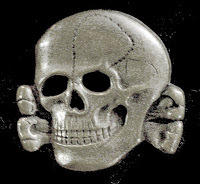 The last time I ever saw Uncle Klaus was in 1939, and though I was still very young, I had some vague notion that Germany was on the eve of war. He was wearing a uniform when he came to see us. Many times in the past he’d been in uniform – uniforms were quite commonplace in those days – but this one was jet black and it sported the SS Sig Runes on its collar and the Totenkopf, or Death’s Head, as they could call it here in England, on its armband. I don’t think Uncle Klaus had come with the express intention of warning my father that he was in imminent danger, but I was sent to my room while the adults discussed matters, and so fierce as the resulting argument that I heard it through the floorboards. Snatches of that dispute still remain in my memory. “Will you continue writing fairy stories while the world burns, Eric?” my uncle demanded to know. “What does it matter if I do?” my father replied. “It matters if they call you ‘traitor’ for it.” “Never once have I written or spoken a word of treason.” “Nor have you written against it. Is it not the case that, several times now, you have been invited to supply poems, ballads and books in honour of our cause, and have always refused? We stand on the brink of a great destiny, and yet you – a man of widespread influence – seem determined to disapprove of it.” “Klaus, I am not a political writer.” “Eric, not everyone agrees with that …” Before Uncle Klaus finally left, I came to the top of the stairs in tears. I might have been a child, but I was not a fool; I knew the sound of irreparable damage when I heard it. He glanced up as he pulled his hat down over his brow and climbed into his long leather coat; his expression was one of deep regret, but also bitter anger and betrayal. He spoke to me, but I was in too anguished a state at the time to make sense of his words. We left our home the very next day, not just our house, but Germany itself. I have almost no memory of that rushed dawn departure as I apparently slept through most of it.
The last time I ever saw Uncle Klaus was in 1939, and though I was still very young, I had some vague notion that Germany was on the eve of war. He was wearing a uniform when he came to see us. Many times in the past he’d been in uniform – uniforms were quite commonplace in those days – but this one was jet black and it sported the SS Sig Runes on its collar and the Totenkopf, or Death’s Head, as they could call it here in England, on its armband. I don’t think Uncle Klaus had come with the express intention of warning my father that he was in imminent danger, but I was sent to my room while the adults discussed matters, and so fierce as the resulting argument that I heard it through the floorboards. Snatches of that dispute still remain in my memory. “Will you continue writing fairy stories while the world burns, Eric?” my uncle demanded to know. “What does it matter if I do?” my father replied. “It matters if they call you ‘traitor’ for it.” “Never once have I written or spoken a word of treason.” “Nor have you written against it. Is it not the case that, several times now, you have been invited to supply poems, ballads and books in honour of our cause, and have always refused? We stand on the brink of a great destiny, and yet you – a man of widespread influence – seem determined to disapprove of it.” “Klaus, I am not a political writer.” “Eric, not everyone agrees with that …” Before Uncle Klaus finally left, I came to the top of the stairs in tears. I might have been a child, but I was not a fool; I knew the sound of irreparable damage when I heard it. He glanced up as he pulled his hat down over his brow and climbed into his long leather coat; his expression was one of deep regret, but also bitter anger and betrayal. He spoke to me, but I was in too anguished a state at the time to make sense of his words. We left our home the very next day, not just our house, but Germany itself. I have almost no memory of that rushed dawn departure as I apparently slept through most of it.*
Grandpa Ludwig sipped his port. The mood had turned rapidly and unexpectedly sombre. His family’s narrow escape from Nazi Germany had never been the easiest topic of conversation. His writer father, though he’d adopted England as his new abode, had been haunted to the end of his days by his inability to reconcile himself with a homeland whose history and culture he had loved but which had been subverted to such a ghastly degree that he no longer knew it when he left. Grandpa Ludwig, of course, had barely experienced Germany. He now had only the faintest discernible accent, and though his early days were undoubtedly difficult – a boy named Weidmann living in postwar Britain! – he soon adapted to his new home and in time became as English as Winston Churchill. Perhaps this was why, after another contemplative sip or two, he was able to continue with his narrative. Though his mood was no lighter. Far from it …
*
We must move forward now, to the Christmas Eve of 1948. To an eleven-year-old those pre-war days already seemed a receding memory, but the good times had not yet returned. Britain was a land of food rationing, bombed cities and bereaved families. Ironically, though my family were immigrants, our position was better than some. My father had learned to speak English, but never to a standard where he might write in that tongue, at least not with the same eloquence he’d shown when writing in German. However, he was able to teach, so we had regular money and a reasonably comfortable home in the suburbs. My two best friends at the time were Billy Flynn and Peter Osgood, boys from the same road in which I lived and fellow pupils at the Catholic school I attended. Both their fathers had fought in the war, and survived – one had even been present at the relief of Belsen – so to them any German who’d annoyed the Nazis to the point where they’d driven him into exile was someone to be admired. Hence, they never treated me like an outsider. Hard though youngsters may find it to believe now, on the Christmas Eve in question we were required to attend school as if it were any normal day. We had a two-week holiday, but it only commenced the following morning on Christmas Day. For all that, our teachers were kind enough to release us at lunchtime, so Billy, Peter and I took the opportunity to divert through the town centre on our way home. There was a raw, wintry feel that afternoon. The snow that had fallen the previous week had thawed a little, but had later frozen again, and great, dirty mounds of it were now piled at the end of each pavement. The gutters and bus shelters sparkled with icicles; white frost covered every branch and blade of grass. We were well wrapped in our coats and scarves; we had our balaclavas and our woollen mittens. Even so, there is only so much one can do to fend off that depth of cold, but we were determined to endure it because a great treat awaited us. The English version our German Saint Nikolaus is of course Father Christmas. They share much in common. Both are fat, jolly men with white curls and white beards. They wear warm winter robes and dispense presents to good children. There are some differences.
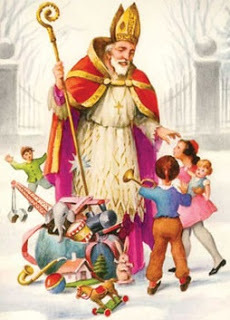 In Germany, Saint Nikolaus would visit homes on the eve of December 6th, whereas in England, Father Christmas would visit on Christmas Eve itself. While Saint Nikolaus bore ecclesial accoutrements – for instance, he wore a mitre and carried a crosier – the English Father Christmas had a druidic air; there was something in his makeup of the old spirit of winter, which, looking on it as an adult, seems almost pagan to me. But even so, in England, as in Germany, children were taught that this benign figure was a saint, beloved of Christ, so his magical gifts were to be welcomed and adored. As a small side-matter … in Germany, St. Nikolaus had a shadowy other-self, little known and an entirely dissimilar personality. But more about him later. The purpose of our diversion into the centre of town that Christmas Eve was concerned neither with Saint Nikolaus nor Father Christmas, but in fact with Santa Claus, their American counterpart, newly introduced to the United Kingdom in the aftermath of the war. Santa Claus, though in many ways indistinguishable from his European brethren, had one very unique attribute: he could actually be spoken to; he would sit children on his knee and they could request their presents face-to-face. I’m talking of course about the famous department store Santa Claus, who had been a fixture in American cities since the turn of the previous century, and now at last had come to Britain. The department store in question was Halley & Meredith’s, whose palatial residence was in the very centre of our town, in a space, if I recall correctly, which is now occupied by a wine bar, a Poundstretcher and a kebab shop. At the time we referred to Halley & Meredith’s as ‘posh’, though in truth it would probably have seemed fairly second rate compared to Harrods in London or Kendals in Manchester. But it occupied a great baroque building, and its frontal canopy was hung with international flags. It even had its own taxi rank outside, the implication being that the sort of people who shopped at Halley & Meredith’scould easily afford to take cabs. One entered the premises through revolving doors, assuming that the concierge on duty – a dapper chap with a military air, wearing a shell grey overcoat with gold braid at its shoulders – would permit you access. Under normal circumstances it seemed highly possible that three schoolboys lacking the governance of their parents would be refused, but this was Christmas Eve and everyone was excited and in a good mood, and in any case, Santa Claus was waiting inside. Or was it Father Christmas or Saint Nikolaus? Or someone else? Halley & Meredith’s seemed vast and crowded that day; we trekked past Scarves, Gloves And Hats, past Cosmetics, past Haberdashery, past Men’s Tailoring, past Ladies’ Shoes, all locations which, when I’d been present with my mother, had signified hours of tedium. But now, to see them decked with tinsel and boughs of evergreen was almost too much for an eleven-year-old to take – our sense of thrill rose inexorably, and of course we still had the ‘Christmas Grotto’ at the end of it all. We finally found this hallowed place down at the basement level, a venue normally reserved for tools and gardening equipment, though now it had become a magical kingdom. In hindsight, it had probably been done quite cheaply, but we walked along a side-aisle which we no longer recognised, passing under arches made of pine branches and hung with multi-coloured Chinese lanterns. Streamers and paper chains were looped across the ceiling. Christmas trees stood on each counter, decked with ornaments and fairy lights. Cotton wool had been laid over racks of goods to imitate snow. In the drab, grey Britain of those immediate post-war years, it was a delightful thing to behold. Even the shop assistants – those straight-backed ladies who always teetered around Halley & Meredith’s in tight skirts and tall heels, looking beautiful but severe – seemed so much more human in green, conical ‘elf’ hats, and also because they were smiling and chattering brightly. Santa Claus himself was quite remarkable. A knee-high white picket fence woven with holly had closed off a small area, and he was in the middle of it, seated on a throne-like chair. He wore the traditional crimson robe trimmed with white fur, and it flowed out around him on all sides; it was far too large to be practical – one could never have walked around in such a garment. Beneath it, he wore a bottle-green waistcoat, crimson pantaloons and black boots, again trimmed with white fur. Of course he had a capacious belly and a thick white beard, which fell almost to his belt-buckle. To complete the picture, there were oodles of gift-wrapped presents stacked behind him, as if he was ready right now to load his sleigh and depart on his goodly mission. There was a hubbub of excitement from the queueing youngsters, most of whom were there with their mothers and grandmothers, or both. It may seem strange now, three eleven-year-olds waiting to see Santa Claus in a department store, but we weren’t the eldest there. Other older children were also present, patiently waiting their turn, eyes fixed with wonder on the resplendent figure. World War Two, with its prolonged loss of life, property and innocence and then the drudgery and austerity that had followed, was entirely responsible for this – in some ways we were older than our age back then, but in others we were much younger. Of course, when Santa’s hearty laughter finally told us our turn had come, we older children didn’t actually sit on the big man’s knee. We advanced through the gate in the wicket fence and stood there politely, hands behind our backs, as he addressed us. “And what do we have here?” he said, his blue eyes twinkling. In keeping with the myth that he hailed from some frozen Tyrolean land, he spoke with a central European accent. “Three young men, in whose steady hands the future of the world must reside.” Peter, always the boldest among us, answered first when we were asked what we were hoping to obtain at Christmas. “I would like a new bicycle, sir,” he said soberly, as if he knew that he really was asking for quite a lot and that such an extravagant gift might be beyond even Santa Claus’s ability to bestow. “A new bicycle, hmmm,” our host rumbled. “We’ll have to see about that, but who knows?, anything is possible.” He switched his attention to Billy. “And for you, young sir?” “I would like a toy gun and holster, sir,” Billy said. “Like you see on the cowboy films. Maybe a cowboy hat as well?” “Hmmm … well, a hat and a gun. Those are quite the sort of items a young man should possess, though you won’t be meeting many Red Indians here in Lancashire, I shouldn’t think.” “No, sir,” Billy said in a tone which suggested he’d given this matter weighty consideration but was still set on his course. “Hmmm … well, this is all to the good, gentlemen. Such manly gifts will prepare you for the trials of adulthood.” This conversation might have seemed a little more protracted than most of those Santa Claus had engaged in up until now, and yet he still didn’t turn to me – and frankly I wasn’t concerned in the least. Because from the moment I’d set eyes upon him up close, I was struck with the kind of horror that even back in the war-ravaged 1940s most people would experience only once in a lifetime. It was Uncle Klaus. That is all I can say. Feel free not to believe me, but I swear to you it is the absolute truth. He’d changed enormously. Beneath that thick, white beard and the rosy cheeks – the former of which was clearly real, the latter fake – he was as gaunt as a leper: his skin had a yellowish tinge; his eyes, which were neither as blue nor as twinkly as I’d first thought, were sunken in skullish cavities; his lips were thin and covered with cracks and sores. But there was no mistaking that horizontal scar on his left cheek, even though many other scars had appeared since. And now at last he turned to me, and he pointed with a long, bony finger, the nail at the end of which was sharp and twisting. “And for you, Ludwig?” he said, though it wasn’t really a question. “Krampus … ja?” “I … I just want to go home,” I stuttered. “Nein!” he said harshly, wagging that terrible finger in admonition and fixing me with a stare so malevolent that it was all I could do not to faint. “Krampus!” The next thing I knew, we were being ushered away down another aisle by one of the elf-ladies, and Peter and Billy were gossiping excitedly about whether or not they had increased their chances of receiving their much sought-for presents. In their eyes at least nothing unusual had happened, and when I glanced back over my shoulder at the diminishing form of Santa Claus in his golden grotto, a little girl was positioned on his knee, shivering with delight as he cuddled her and crooned a carol, and the queue of other children awaiting their own turn had extended until it snaked down the entire length of the department store’s basement. When we emerged outside, it was turning dark and tiny spots of snow were spiralling down. There were many more people about, attending to their last-minute shopping, and the roads were a chaos of vans, wagons and cars. My two friends were still in a state of exhilaration as we commenced the long walk home, so it was difficult broaching the subject of whether or not they’d thought there was something strange about the man masquerading as Santa Claus in Halley & Meredith’s. Clearly, neither had detected anything. Peter did acknowledge that I’d seemed a little tongue-tied when Santa Claus had spoken to me, though he hadn’t noticed the man address me by my own name, and certainly recalled nothing about his use of the term ‘Krampus’.
In Germany, Saint Nikolaus would visit homes on the eve of December 6th, whereas in England, Father Christmas would visit on Christmas Eve itself. While Saint Nikolaus bore ecclesial accoutrements – for instance, he wore a mitre and carried a crosier – the English Father Christmas had a druidic air; there was something in his makeup of the old spirit of winter, which, looking on it as an adult, seems almost pagan to me. But even so, in England, as in Germany, children were taught that this benign figure was a saint, beloved of Christ, so his magical gifts were to be welcomed and adored. As a small side-matter … in Germany, St. Nikolaus had a shadowy other-self, little known and an entirely dissimilar personality. But more about him later. The purpose of our diversion into the centre of town that Christmas Eve was concerned neither with Saint Nikolaus nor Father Christmas, but in fact with Santa Claus, their American counterpart, newly introduced to the United Kingdom in the aftermath of the war. Santa Claus, though in many ways indistinguishable from his European brethren, had one very unique attribute: he could actually be spoken to; he would sit children on his knee and they could request their presents face-to-face. I’m talking of course about the famous department store Santa Claus, who had been a fixture in American cities since the turn of the previous century, and now at last had come to Britain. The department store in question was Halley & Meredith’s, whose palatial residence was in the very centre of our town, in a space, if I recall correctly, which is now occupied by a wine bar, a Poundstretcher and a kebab shop. At the time we referred to Halley & Meredith’s as ‘posh’, though in truth it would probably have seemed fairly second rate compared to Harrods in London or Kendals in Manchester. But it occupied a great baroque building, and its frontal canopy was hung with international flags. It even had its own taxi rank outside, the implication being that the sort of people who shopped at Halley & Meredith’scould easily afford to take cabs. One entered the premises through revolving doors, assuming that the concierge on duty – a dapper chap with a military air, wearing a shell grey overcoat with gold braid at its shoulders – would permit you access. Under normal circumstances it seemed highly possible that three schoolboys lacking the governance of their parents would be refused, but this was Christmas Eve and everyone was excited and in a good mood, and in any case, Santa Claus was waiting inside. Or was it Father Christmas or Saint Nikolaus? Or someone else? Halley & Meredith’s seemed vast and crowded that day; we trekked past Scarves, Gloves And Hats, past Cosmetics, past Haberdashery, past Men’s Tailoring, past Ladies’ Shoes, all locations which, when I’d been present with my mother, had signified hours of tedium. But now, to see them decked with tinsel and boughs of evergreen was almost too much for an eleven-year-old to take – our sense of thrill rose inexorably, and of course we still had the ‘Christmas Grotto’ at the end of it all. We finally found this hallowed place down at the basement level, a venue normally reserved for tools and gardening equipment, though now it had become a magical kingdom. In hindsight, it had probably been done quite cheaply, but we walked along a side-aisle which we no longer recognised, passing under arches made of pine branches and hung with multi-coloured Chinese lanterns. Streamers and paper chains were looped across the ceiling. Christmas trees stood on each counter, decked with ornaments and fairy lights. Cotton wool had been laid over racks of goods to imitate snow. In the drab, grey Britain of those immediate post-war years, it was a delightful thing to behold. Even the shop assistants – those straight-backed ladies who always teetered around Halley & Meredith’s in tight skirts and tall heels, looking beautiful but severe – seemed so much more human in green, conical ‘elf’ hats, and also because they were smiling and chattering brightly. Santa Claus himself was quite remarkable. A knee-high white picket fence woven with holly had closed off a small area, and he was in the middle of it, seated on a throne-like chair. He wore the traditional crimson robe trimmed with white fur, and it flowed out around him on all sides; it was far too large to be practical – one could never have walked around in such a garment. Beneath it, he wore a bottle-green waistcoat, crimson pantaloons and black boots, again trimmed with white fur. Of course he had a capacious belly and a thick white beard, which fell almost to his belt-buckle. To complete the picture, there were oodles of gift-wrapped presents stacked behind him, as if he was ready right now to load his sleigh and depart on his goodly mission. There was a hubbub of excitement from the queueing youngsters, most of whom were there with their mothers and grandmothers, or both. It may seem strange now, three eleven-year-olds waiting to see Santa Claus in a department store, but we weren’t the eldest there. Other older children were also present, patiently waiting their turn, eyes fixed with wonder on the resplendent figure. World War Two, with its prolonged loss of life, property and innocence and then the drudgery and austerity that had followed, was entirely responsible for this – in some ways we were older than our age back then, but in others we were much younger. Of course, when Santa’s hearty laughter finally told us our turn had come, we older children didn’t actually sit on the big man’s knee. We advanced through the gate in the wicket fence and stood there politely, hands behind our backs, as he addressed us. “And what do we have here?” he said, his blue eyes twinkling. In keeping with the myth that he hailed from some frozen Tyrolean land, he spoke with a central European accent. “Three young men, in whose steady hands the future of the world must reside.” Peter, always the boldest among us, answered first when we were asked what we were hoping to obtain at Christmas. “I would like a new bicycle, sir,” he said soberly, as if he knew that he really was asking for quite a lot and that such an extravagant gift might be beyond even Santa Claus’s ability to bestow. “A new bicycle, hmmm,” our host rumbled. “We’ll have to see about that, but who knows?, anything is possible.” He switched his attention to Billy. “And for you, young sir?” “I would like a toy gun and holster, sir,” Billy said. “Like you see on the cowboy films. Maybe a cowboy hat as well?” “Hmmm … well, a hat and a gun. Those are quite the sort of items a young man should possess, though you won’t be meeting many Red Indians here in Lancashire, I shouldn’t think.” “No, sir,” Billy said in a tone which suggested he’d given this matter weighty consideration but was still set on his course. “Hmmm … well, this is all to the good, gentlemen. Such manly gifts will prepare you for the trials of adulthood.” This conversation might have seemed a little more protracted than most of those Santa Claus had engaged in up until now, and yet he still didn’t turn to me – and frankly I wasn’t concerned in the least. Because from the moment I’d set eyes upon him up close, I was struck with the kind of horror that even back in the war-ravaged 1940s most people would experience only once in a lifetime. It was Uncle Klaus. That is all I can say. Feel free not to believe me, but I swear to you it is the absolute truth. He’d changed enormously. Beneath that thick, white beard and the rosy cheeks – the former of which was clearly real, the latter fake – he was as gaunt as a leper: his skin had a yellowish tinge; his eyes, which were neither as blue nor as twinkly as I’d first thought, were sunken in skullish cavities; his lips were thin and covered with cracks and sores. But there was no mistaking that horizontal scar on his left cheek, even though many other scars had appeared since. And now at last he turned to me, and he pointed with a long, bony finger, the nail at the end of which was sharp and twisting. “And for you, Ludwig?” he said, though it wasn’t really a question. “Krampus … ja?” “I … I just want to go home,” I stuttered. “Nein!” he said harshly, wagging that terrible finger in admonition and fixing me with a stare so malevolent that it was all I could do not to faint. “Krampus!” The next thing I knew, we were being ushered away down another aisle by one of the elf-ladies, and Peter and Billy were gossiping excitedly about whether or not they had increased their chances of receiving their much sought-for presents. In their eyes at least nothing unusual had happened, and when I glanced back over my shoulder at the diminishing form of Santa Claus in his golden grotto, a little girl was positioned on his knee, shivering with delight as he cuddled her and crooned a carol, and the queue of other children awaiting their own turn had extended until it snaked down the entire length of the department store’s basement. When we emerged outside, it was turning dark and tiny spots of snow were spiralling down. There were many more people about, attending to their last-minute shopping, and the roads were a chaos of vans, wagons and cars. My two friends were still in a state of exhilaration as we commenced the long walk home, so it was difficult broaching the subject of whether or not they’d thought there was something strange about the man masquerading as Santa Claus in Halley & Meredith’s. Clearly, neither had detected anything. Peter did acknowledge that I’d seemed a little tongue-tied when Santa Claus had spoken to me, though he hadn’t noticed the man address me by my own name, and certainly recalled nothing about his use of the term ‘Krampus’.  Not that they would have known what it meant, anyway. Not that anyone in this country would have known. You see, Krampus was the name given to that shadowy other-self of Saint Nikolaus, the one I referred to earlier. Whereas in English-speaking lands, Father Christmas and Santa Claus have always preferred to ignore naughty children, in Germanic countries Krampus actively punishes them. I had seen illustrations of him in children’s books written by my father, and he is truly grotesque; a monster, a deformed devil with horns, hooves and a humped back. The sack he carries is not intended for the provision of gifts, but to abduct those misbehaving youths he encounters on his travels, and to carry them back to his lair where all manner of torments will be inflicted on them. You look shocked. Don’t be. In the days of my youth, children were to be seen and not heard. Parents, while loving, were stern. There was a price to pay for transgression. Bad behaviour was never tolerated. Even now, it pains me to recollect that journey home from the shops. I was so distressed by what had happened that I contributed almost nothing to my friends’ joyous jabber. All of a sudden, Christmas – the culmination of so many weeks’ eager anticipation, the date we had ached for since the onset of winter – meant nothing to me. The ruddy glow of Yule candles in passing windows, the falling snow – now a thickening, shimmering cascade – should have rendered a perfect setting. But my thoughts were in turmoil. More than once I glanced over my shoulder, especially after we left the town centre and entered the residential districts, where doors were closed, curtains drawn and fellow pedestrians little more than occasional muffled shadows. Though I never saw anything amiss, I was increasingly certain that someone was keeping pace with us just beyond the range of our vision. At last the moment came when we were to go our different ways. We stopped beneath a corner streetlamp, Peter and Billy pumping my hand, clapping my shoulder, wishing me all the best for the season. “A little touch of Germany for you tonight, Ludwig,” Peter said. “What do you mean?” I demanded, even more unnerved. “This!” he said, smiling, indicating the snow. “We get this now and then at Christmas, but in Germany you get it every year, or so I’m told.” “Not every year,” I replied, still shaken. “Happy Christmas anyway, Ludwig!” they shouted as they walked away, leaving me alone in the lamplight, flakes swirling past. I looked again over my shoulder.
Not that they would have known what it meant, anyway. Not that anyone in this country would have known. You see, Krampus was the name given to that shadowy other-self of Saint Nikolaus, the one I referred to earlier. Whereas in English-speaking lands, Father Christmas and Santa Claus have always preferred to ignore naughty children, in Germanic countries Krampus actively punishes them. I had seen illustrations of him in children’s books written by my father, and he is truly grotesque; a monster, a deformed devil with horns, hooves and a humped back. The sack he carries is not intended for the provision of gifts, but to abduct those misbehaving youths he encounters on his travels, and to carry them back to his lair where all manner of torments will be inflicted on them. You look shocked. Don’t be. In the days of my youth, children were to be seen and not heard. Parents, while loving, were stern. There was a price to pay for transgression. Bad behaviour was never tolerated. Even now, it pains me to recollect that journey home from the shops. I was so distressed by what had happened that I contributed almost nothing to my friends’ joyous jabber. All of a sudden, Christmas – the culmination of so many weeks’ eager anticipation, the date we had ached for since the onset of winter – meant nothing to me. The ruddy glow of Yule candles in passing windows, the falling snow – now a thickening, shimmering cascade – should have rendered a perfect setting. But my thoughts were in turmoil. More than once I glanced over my shoulder, especially after we left the town centre and entered the residential districts, where doors were closed, curtains drawn and fellow pedestrians little more than occasional muffled shadows. Though I never saw anything amiss, I was increasingly certain that someone was keeping pace with us just beyond the range of our vision. At last the moment came when we were to go our different ways. We stopped beneath a corner streetlamp, Peter and Billy pumping my hand, clapping my shoulder, wishing me all the best for the season. “A little touch of Germany for you tonight, Ludwig,” Peter said. “What do you mean?” I demanded, even more unnerved. “This!” he said, smiling, indicating the snow. “We get this now and then at Christmas, but in Germany you get it every year, or so I’m told.” “Not every year,” I replied, still shaken. “Happy Christmas anyway, Ludwig!” they shouted as they walked away, leaving me alone in the lamplight, flakes swirling past. I looked again over my shoulder.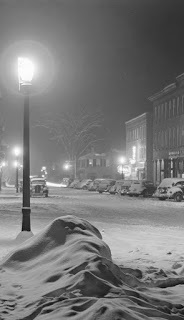 The street we had just walked along was lined down either side with terraced houses; a perfectly normal street in our part of the world, yet now an increasingly stiff breeze was whipping the snow in eddies – on some occasions I could see as far along it as the coal wagon parked at its distant end, on others no more than thirty yards. I remained there for several minutes, convinced there’d be something to fix on if only I could gaze into the murk hard enough. Intermittently down that street, curtains were only half-drawn, thus allowing rays of soft, warm lamplight to penetrate outward. Without warning, someone passed one of these. I blinked – and they’d gone again, hidden by renewed swirls of flakes. But it was someone headed in my direction. Someone wearing red. It could have been any ordinary person walking home; there was absolutely no need to assume the worst. But briefly I was rooted in place. Only slowly, with great difficulty, was I able to retreat to the edge of the pavement, where again I waited. I don’t know why; it makes no sense now – it was as if I had some inner urgent need to know I was in danger rather than simply fear it. But then something happened that leant genuine panic to my heels. I spied the figure again, much closer this time – maybe forty yards away – crossing the street to the side on which I was waiting. It was only a silhouette, half-glimpsed as it passed through another shaft of flake-speckled lamplight, but it was bent forward in ungainly fashion, its back humped, its heavy robes trailing behind it. There was no further debate in my mind. I spun around and raced blindly along the next street, and along the one after that, regardless of the treacherous footing. I must have covered half the distance home before I stopped to get my breath. I had seen no-one else that whole way, but likewise no-one was in sight behind me either, and now, the flakes having relented a little, I was able to see a good distance in every direction – and spied nothing but snow-covered road junctions, the red-brick gable walls of houses, the weak palls of light cast by streetlamps. Nothing advanced through them, so I felt a little better, though I had yet to cross Dalewood Brow. That place no longer exists today – a supermarket and offices have been built there instead, but in my childhood it consisted of several hundred yards of derelict colliery land, hummocky and deeply overgrown; a wonderful place for children to play in summer, but in wintry darkness a test of anyone’s nerve. Especially on this occasion. I didn’t need to go over the Brow. If I turned left at this point I could just as easily walk around it, making my way home via lamp-lit streets, passing more houses, more cars. Yet that would take much longer – maybe add half an hour to my journey, and all at once I wanted desperately to be home, if for no other reason than my fingers were frozen and my feet turning numb. So I pushed open the creaky gate in the wrought iron fence that ran along the Brow’s edge, and set off hurriedly up its winding, cindery path. Because the Brow was covered with snow, much more of it was visible to me than I’d expected, and somehow that was comforting. All the way I glanced nervously around, able to see a vast expanse of white, broken only by the occasional black skeletons of trees, or protruding twists of frosty underbrush. I quickly lost sight of the wrought iron fence, but my confidence was growing that I would soon be home. I was approaching the Hump, as we knew it – a great slagheap with a foot-tunnel driven through it; beyond that I needed only to cross the canal bridge, and ascend a footpath through thickets to the edge of the housing estate on which I lived. That was when I heard the distant creak of the gate. Did I actually hear it? Was it possible to hear anything in that situation? The gate was dozens and dozens of yards behind me. My ears were muffled by the balaclava. Even if I had heard it, might it not have been shifted by a gust of wind? I couldn’t see far enough back in this twilit snowy realm to be sure one way or the other, but then I heard something else – the steady crunch of approaching feet. I didn’t wait to hear more. I ran on up the remainder of the path and through the foot-tunnel. This in itself – a straight low corridor of damp brick, completely unlit, running for at least fifty yards – would be a nightmare in the modern age, but notions of ‘stranger-danger’ were almost unheard of in that long-ago era. I was nearly home; this foot-tunnel was part of my normal world; I had no fear of it – until this point. Because though I got through to the other side without hindrance, I stopped again, for no good reason I can think of now, and peered back, and to my utmost shock I beheld a figure entering the tunnel from the other side. Again it was nothing more than a silhouette framed on the moon-lit snow, but, as before, it was hunched forward – so much so that I couldn’t see its head, and it moved with a heavy, shambling gait; immense, unwieldy robes dragged behind it. The clomping of its footfalls on the stony ground echoed along the passage towards me; those sounds were like no impacts of shoes or boots that I’d ever heard. I simply fled. Raw terror drove me across the canal bridge at reckless speed – it had no safety barriers and was shod with ice, yet I careered over it like a madman. The path beyond led uphill through tangled, snow-clad thickets. There were any number of places where an assailant might lie in wait and leap out, but I bypassed them all without a glance. Even when I left the Brow and ran along the next street to my own, I was pursued by inexorable fear, which only intensified as I rounded the corner onto the final straight – I had a nagging certainty that I’d be grabbed at the death. I wasn’t, but worse was to follow. With sobs of relief, I kicked open our garden gate and ran up the path. The front door was locked, so I veered left, running down the side alley past our allotment and coal-bunker, to the kitchen door – to my disbelief, this was locked too. I fumbled wildly under the scullery window, found our spare key, and let myself in, slamming the door closed behind me. The next thing I noticed was the cold supper waiting on the kitchen table – some boiled bacon, bread and jam, a mug of milk – with a handwritten letter alongside it. Though the house was luxuriously warm, coals burning in both the kitchen stove and behind the fireguard on the grate in the living room, a new kind of chill struck me. My parents were out. I knew that before I even snatched up the note and began to read. It was from my father, and it explained that he and my mother had been invited round by neighbours for a Christmas Eve drink. They would only be a couple of hours. But which neighbours? He didn’t specify. And when had this couple of hours commenced? Was it shortly to expire or did it still stretch before me? I yanked off my balaclava, my hair soaked with icy sweat – and heard a distinctive clank as the front gate banged open again. Incredulously, I listened to the progression of heavy, misshapen feet along our snowy front path, and then into the alley beside the house, whereupon they abruptly stopped. I was now listening so intently that I fancied I could hear the whispering of the snowflakes outside, but apart from that there was only silence. Torturous, prolonged silence. It is almost impossible to convey the horror and isolation I felt at that moment, even though I was ensconced in my own home. I stared fixedly at the kitchen door. For a time, there was nothing else in the world but that door – and what I suspected lurked just beyond it. I was unable to move; I didn’t dare move, terrified that if my feet scuffed on the floor they would alert the thing to my presence, even though such thoughts were patently ludicrous – it had followed me all the way home. Even if it hadn’t, it knew where I lived; according to our myths, it knew where every child lived. There was a soft crunch of snow, this directly on the other side of the door, and then a further pause. Was it listening in through the planks as I was listening out? We had a telephone – I don’t know why it never occurred to me to run and dial 999. I suspect I was simply too mesmerised by events. My nerves were taut as cello strings, my hair standing on end. But I quickly broke from this stupor when the door-handle started to turn. I think I may have screamed aloud as I lurched forward and rammed home the upper bolt. Immediately, the handle ceased moving. There was another prolonged silence. I stood rigid, eyes goggling, awaiting the next move. Then the handle turned again, this time with violence, and there was a long, dull groan as a significant weight was pressed against the door from the other side. I was far from confident the single bolt would hold, especially when the weight was withdrawn and, instead, a heavy blow landed. Followed by another blow and another; loud, echoing reports, increasingly angry, which must have been heard all along our street. The kitchen door was solid oak, but it shook and shook, and I imagined that its screws would flirt from their moorings under such an assault. It was a sure sign of how enthralled by fear I was that only now did it strike me to drive home the lower bolt as well. At first this was difficult: the assailant was hammering on the woodwork, not just with hands but with feet like iron clubs, and the lower section of the door vibrated so hard that it rarely lined up with the jamb – so hard that I thought it would shatter inward – but at last I managed to slide the bolt into its mount, and then ram my key into the lock and turn that too. All violence without instantly ceased. The silence that followed this was perhaps the worst part of it, for all I could do was hover there in a state of near-paralysis, unsure whether my unwanted visitor had slunk off into the night, or was still present, contemplating another means of ingress. When I suddenly heard a clunk of metal at the front of the house, I shrieked hoarsely and stumbled through into our entrance hall, but not without first taking my mother’s rolling pin from one of the kitchen work-tops. I still remember vividly how that hall seemed to elongate before me, to telescope out to inordinate length as I stood at the kitchen end and peered down it, past the evergreens draped over the stair banister, past the telephone table, past the wooden coat stand, to the front door itself, which, even as I watched, began to open. I dashed down there with rolling pin raised, like some fearless warrior, screaming. But I was actually on my last legs, and I tripped on the rug before I got there, and found myself pitching forward – into the arms of my astonished father. Neither he nor my mother could speak they were so taken by surprise, but it soon became clear to them from my flow of semi-delirious gibberish that I was not playing some silly game. Despite my pleas that he lock all the doors and call for police assistance, my father went promptly down the side alley to the rear of the house. He found nobody lurking there, but with the aid of a candle, he noted extensive damage to our kitchen door. Afterwards, he listened again to the tale I had to tell him, and I left nothing out – but though he turned a trifle pale at my mention of the department store Santa Claus who’d appeared to know me and looked like Uncle Klaus, I don’t think he really believed that part of it. Though I was eleven years old, I spent that Christmas Eve in my parents’ bed, alongside my mother. My father slept in the armchair downstairs, next to the fire, which he stoked up to a good blaze before switching off the lights. Apparently he spent an uncomfortable but undisturbed night, and never once relinquished his grip on the poker. By morning, a fresh snowfall had obliterated all traces of footprints on our property. In a strange way, I was quite glad of that – I had no desire to see the shape of those left by our Christmas Eve intruder.
The street we had just walked along was lined down either side with terraced houses; a perfectly normal street in our part of the world, yet now an increasingly stiff breeze was whipping the snow in eddies – on some occasions I could see as far along it as the coal wagon parked at its distant end, on others no more than thirty yards. I remained there for several minutes, convinced there’d be something to fix on if only I could gaze into the murk hard enough. Intermittently down that street, curtains were only half-drawn, thus allowing rays of soft, warm lamplight to penetrate outward. Without warning, someone passed one of these. I blinked – and they’d gone again, hidden by renewed swirls of flakes. But it was someone headed in my direction. Someone wearing red. It could have been any ordinary person walking home; there was absolutely no need to assume the worst. But briefly I was rooted in place. Only slowly, with great difficulty, was I able to retreat to the edge of the pavement, where again I waited. I don’t know why; it makes no sense now – it was as if I had some inner urgent need to know I was in danger rather than simply fear it. But then something happened that leant genuine panic to my heels. I spied the figure again, much closer this time – maybe forty yards away – crossing the street to the side on which I was waiting. It was only a silhouette, half-glimpsed as it passed through another shaft of flake-speckled lamplight, but it was bent forward in ungainly fashion, its back humped, its heavy robes trailing behind it. There was no further debate in my mind. I spun around and raced blindly along the next street, and along the one after that, regardless of the treacherous footing. I must have covered half the distance home before I stopped to get my breath. I had seen no-one else that whole way, but likewise no-one was in sight behind me either, and now, the flakes having relented a little, I was able to see a good distance in every direction – and spied nothing but snow-covered road junctions, the red-brick gable walls of houses, the weak palls of light cast by streetlamps. Nothing advanced through them, so I felt a little better, though I had yet to cross Dalewood Brow. That place no longer exists today – a supermarket and offices have been built there instead, but in my childhood it consisted of several hundred yards of derelict colliery land, hummocky and deeply overgrown; a wonderful place for children to play in summer, but in wintry darkness a test of anyone’s nerve. Especially on this occasion. I didn’t need to go over the Brow. If I turned left at this point I could just as easily walk around it, making my way home via lamp-lit streets, passing more houses, more cars. Yet that would take much longer – maybe add half an hour to my journey, and all at once I wanted desperately to be home, if for no other reason than my fingers were frozen and my feet turning numb. So I pushed open the creaky gate in the wrought iron fence that ran along the Brow’s edge, and set off hurriedly up its winding, cindery path. Because the Brow was covered with snow, much more of it was visible to me than I’d expected, and somehow that was comforting. All the way I glanced nervously around, able to see a vast expanse of white, broken only by the occasional black skeletons of trees, or protruding twists of frosty underbrush. I quickly lost sight of the wrought iron fence, but my confidence was growing that I would soon be home. I was approaching the Hump, as we knew it – a great slagheap with a foot-tunnel driven through it; beyond that I needed only to cross the canal bridge, and ascend a footpath through thickets to the edge of the housing estate on which I lived. That was when I heard the distant creak of the gate. Did I actually hear it? Was it possible to hear anything in that situation? The gate was dozens and dozens of yards behind me. My ears were muffled by the balaclava. Even if I had heard it, might it not have been shifted by a gust of wind? I couldn’t see far enough back in this twilit snowy realm to be sure one way or the other, but then I heard something else – the steady crunch of approaching feet. I didn’t wait to hear more. I ran on up the remainder of the path and through the foot-tunnel. This in itself – a straight low corridor of damp brick, completely unlit, running for at least fifty yards – would be a nightmare in the modern age, but notions of ‘stranger-danger’ were almost unheard of in that long-ago era. I was nearly home; this foot-tunnel was part of my normal world; I had no fear of it – until this point. Because though I got through to the other side without hindrance, I stopped again, for no good reason I can think of now, and peered back, and to my utmost shock I beheld a figure entering the tunnel from the other side. Again it was nothing more than a silhouette framed on the moon-lit snow, but, as before, it was hunched forward – so much so that I couldn’t see its head, and it moved with a heavy, shambling gait; immense, unwieldy robes dragged behind it. The clomping of its footfalls on the stony ground echoed along the passage towards me; those sounds were like no impacts of shoes or boots that I’d ever heard. I simply fled. Raw terror drove me across the canal bridge at reckless speed – it had no safety barriers and was shod with ice, yet I careered over it like a madman. The path beyond led uphill through tangled, snow-clad thickets. There were any number of places where an assailant might lie in wait and leap out, but I bypassed them all without a glance. Even when I left the Brow and ran along the next street to my own, I was pursued by inexorable fear, which only intensified as I rounded the corner onto the final straight – I had a nagging certainty that I’d be grabbed at the death. I wasn’t, but worse was to follow. With sobs of relief, I kicked open our garden gate and ran up the path. The front door was locked, so I veered left, running down the side alley past our allotment and coal-bunker, to the kitchen door – to my disbelief, this was locked too. I fumbled wildly under the scullery window, found our spare key, and let myself in, slamming the door closed behind me. The next thing I noticed was the cold supper waiting on the kitchen table – some boiled bacon, bread and jam, a mug of milk – with a handwritten letter alongside it. Though the house was luxuriously warm, coals burning in both the kitchen stove and behind the fireguard on the grate in the living room, a new kind of chill struck me. My parents were out. I knew that before I even snatched up the note and began to read. It was from my father, and it explained that he and my mother had been invited round by neighbours for a Christmas Eve drink. They would only be a couple of hours. But which neighbours? He didn’t specify. And when had this couple of hours commenced? Was it shortly to expire or did it still stretch before me? I yanked off my balaclava, my hair soaked with icy sweat – and heard a distinctive clank as the front gate banged open again. Incredulously, I listened to the progression of heavy, misshapen feet along our snowy front path, and then into the alley beside the house, whereupon they abruptly stopped. I was now listening so intently that I fancied I could hear the whispering of the snowflakes outside, but apart from that there was only silence. Torturous, prolonged silence. It is almost impossible to convey the horror and isolation I felt at that moment, even though I was ensconced in my own home. I stared fixedly at the kitchen door. For a time, there was nothing else in the world but that door – and what I suspected lurked just beyond it. I was unable to move; I didn’t dare move, terrified that if my feet scuffed on the floor they would alert the thing to my presence, even though such thoughts were patently ludicrous – it had followed me all the way home. Even if it hadn’t, it knew where I lived; according to our myths, it knew where every child lived. There was a soft crunch of snow, this directly on the other side of the door, and then a further pause. Was it listening in through the planks as I was listening out? We had a telephone – I don’t know why it never occurred to me to run and dial 999. I suspect I was simply too mesmerised by events. My nerves were taut as cello strings, my hair standing on end. But I quickly broke from this stupor when the door-handle started to turn. I think I may have screamed aloud as I lurched forward and rammed home the upper bolt. Immediately, the handle ceased moving. There was another prolonged silence. I stood rigid, eyes goggling, awaiting the next move. Then the handle turned again, this time with violence, and there was a long, dull groan as a significant weight was pressed against the door from the other side. I was far from confident the single bolt would hold, especially when the weight was withdrawn and, instead, a heavy blow landed. Followed by another blow and another; loud, echoing reports, increasingly angry, which must have been heard all along our street. The kitchen door was solid oak, but it shook and shook, and I imagined that its screws would flirt from their moorings under such an assault. It was a sure sign of how enthralled by fear I was that only now did it strike me to drive home the lower bolt as well. At first this was difficult: the assailant was hammering on the woodwork, not just with hands but with feet like iron clubs, and the lower section of the door vibrated so hard that it rarely lined up with the jamb – so hard that I thought it would shatter inward – but at last I managed to slide the bolt into its mount, and then ram my key into the lock and turn that too. All violence without instantly ceased. The silence that followed this was perhaps the worst part of it, for all I could do was hover there in a state of near-paralysis, unsure whether my unwanted visitor had slunk off into the night, or was still present, contemplating another means of ingress. When I suddenly heard a clunk of metal at the front of the house, I shrieked hoarsely and stumbled through into our entrance hall, but not without first taking my mother’s rolling pin from one of the kitchen work-tops. I still remember vividly how that hall seemed to elongate before me, to telescope out to inordinate length as I stood at the kitchen end and peered down it, past the evergreens draped over the stair banister, past the telephone table, past the wooden coat stand, to the front door itself, which, even as I watched, began to open. I dashed down there with rolling pin raised, like some fearless warrior, screaming. But I was actually on my last legs, and I tripped on the rug before I got there, and found myself pitching forward – into the arms of my astonished father. Neither he nor my mother could speak they were so taken by surprise, but it soon became clear to them from my flow of semi-delirious gibberish that I was not playing some silly game. Despite my pleas that he lock all the doors and call for police assistance, my father went promptly down the side alley to the rear of the house. He found nobody lurking there, but with the aid of a candle, he noted extensive damage to our kitchen door. Afterwards, he listened again to the tale I had to tell him, and I left nothing out – but though he turned a trifle pale at my mention of the department store Santa Claus who’d appeared to know me and looked like Uncle Klaus, I don’t think he really believed that part of it. Though I was eleven years old, I spent that Christmas Eve in my parents’ bed, alongside my mother. My father slept in the armchair downstairs, next to the fire, which he stoked up to a good blaze before switching off the lights. Apparently he spent an uncomfortable but undisturbed night, and never once relinquished his grip on the poker. By morning, a fresh snowfall had obliterated all traces of footprints on our property. In a strange way, I was quite glad of that – I had no desire to see the shape of those left by our Christmas Eve intruder.*
Grandpa Ludwig lapsed into distant memory as he sipped his port wine. “Surely there was some kind of investigation?” my dad finally asked. Clearly, this was the first time he’d ever heard this particular story. Grandpa Ludwig nodded. “Absolutely. At the first opportunity my father sought out the general manager of Halley & Meredith’s to officially complain that their Santa Claus had frightened me, and that he might well be the same person who had followed me home. Even the police became involved, and the Santa Claus in question – his name was William Harrison, and he was an out-of-work actor – was spoken to at length. Of course, Harrison denied any responsibility, and insisted that he was of good character. Others vouched for him, including fellow staff at Halley & Meredith’s, who also provided an alibi, claiming to have shared a festive tipple with him once their work that Christmas Eve had finished. And indeed, when I was eventually shown a photograph of Harrison, it was a completely different man. This ended police enquiries at the store, for Halley & Meredith’s had no other gentlemen employed in the role of Santa Claus.” “That can’t have been the end of the matter?” someone else asked. “Far from it.” Grandpa Ludwig shifted to get comfortable in his armchair. “The news had got out, and there was wide concern in our town that someone – nobody knew who – had followed a child home and tried to force entry to his house. The police continued to ask questions for quite some time. It was perhaps two years later when my father finally contacted them to say that he was sorry for all this trouble, but that he felt I had simply fallen asleep while alone in the house on Christmas Eve and had suffered a nightmare.” “Did you?” my mum asked gently. “Not a bit of it.” “So what brought your father to this conclusion?” Grandpa Ludwig shrugged. “It’s anyone’s guess, but it was quite a coincidence, I think, that around this time we learned the fate of Uncle Klaus. It seemed he’d been taken as a prisoner of war by the Soviets in 1944, and eventually, when hostilities were over, had been put on trial, accused of leading his unit in the massacres of civilians in Poland and Belarus. He was found guilty as charged, and executed by hanging. I’m not sure of the exact date … but it was some time in December 1948.”
Even my dad was speechless; evidently he’d never heard this part of the story before either. The snapping and spitting of chestnut shells finally brought us round. “Krampus,” my auntie said with distaste. “What a horrible being to conjure up at Christmas time. The flipside of everything that is good and kind and forgiving.” Grandpa Ludwig nodded. “As Uncle Klaus said to me.” “When did he say that?” my dad asked. “If you never saw him again?” Grandpa glanced up, his spectacles glinting with firelight. “Why … that final night before the war, after the argument with his twin brother, when he left our house in Mittenwald. At the time his exact words were lost on me, but since then I’ve remembered. He said: ‘Be warned, Ludwig … there aren’t just good fairies in your father’s stories. There are bad ones too’.”

***
If you've enjoyed this story, which hopefully you have, you might be interested to know that late last year I put several of my Christmas chillers out as an e-collection called IN A DEEP, DARK DECEMBER. You can still buy it HERE for the non-too-princely sum of 99p. You might also be interested in the 2010 novella of mine, SPARROWHAWK, which is also still available as an e-book, though sadly out of print in paperback. This is probably the most Christmassy of all my Christmas ghost stories, and set right in the heart of the season - in Dickens's London, during the bitterly cold December of 1843. Grab this one HERE , for £2.41.
(The pic at the top is freely lifted from the Dutch festive horror movie, SINT. Check it out - it's well worth it).
Published on December 08, 2015 11:13
December 1, 2015
To fight and die in a tragically fallen world
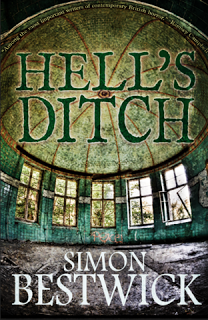 An author you're going to hear a lot more about in the near future is SIMON BESTWICK. A Cheshire lad by origin, now based in Liverpool, he specialises in novels and short stories that tend to straddle the horror and thriller subgenres. He's also something of an urban poet, determinedly examining every aspect of modern post-industrial life, which, while it's often bleak and unforgiving, in Simon Bestwick's hands is also dark, mysterious, compelling, and thanks to his lyrical descriptive powers, entrancing. Simon also writes with a conscience and a hard-edged political awareness, which elevates his work from the purely entertaining into something far more potent and thought-provoking.
An author you're going to hear a lot more about in the near future is SIMON BESTWICK. A Cheshire lad by origin, now based in Liverpool, he specialises in novels and short stories that tend to straddle the horror and thriller subgenres. He's also something of an urban poet, determinedly examining every aspect of modern post-industrial life, which, while it's often bleak and unforgiving, in Simon Bestwick's hands is also dark, mysterious, compelling, and thanks to his lyrical descriptive powers, entrancing. Simon also writes with a conscience and a hard-edged political awareness, which elevates his work from the purely entertaining into something far more potent and thought-provoking.Anyway, that's enough from me. Suffice to say that that Simon's new book, HELL'S DITCH, is published today by Snowbooks, and when the suggestion was made that he use this blog to write a guest blog and blurb his new book any way he saw fit, I thought why the hell not? So here it is, HELL'S DITCH - published today (just follow the link) - in the author's own words:
'"A fallen world" is a phrase a Christian friend of mine used, and while I’m not religious, it does have a certain ring to it. And it does rather describe the world of my new book – published today! – which is called Hell’s Ditch.
'Like pretty much anyone born before the end of the 1970s, I grew up with the threat of nuclear war. It was something that could very easily have happened, and there was stuff about it wherever you looked.
 'It wasn’t just a topic of discussion on news and current affairs programmes – there were heavy metal songs (Two Minutes To Midnight) pop songs about it (Enola Gay, Dancing With Tears In My Eyes, 99 Red Balloons), books about it – post-apocalyptic action-adventures like The Survivalist, YA books like Brother In The Land, horror novels like Domain – and there were films about it (Threads, The Day After, Mad Max.) It was everywhere.
'It wasn’t just a topic of discussion on news and current affairs programmes – there were heavy metal songs (Two Minutes To Midnight) pop songs about it (Enola Gay, Dancing With Tears In My Eyes, 99 Red Balloons), books about it – post-apocalyptic action-adventures like The Survivalist, YA books like Brother In The Land, horror novels like Domain – and there were films about it (Threads, The Day After, Mad Max.) It was everywhere.'And then the Cold War ended, and the threat just went away.
'Except…
'Well, it hasn’t gone away, not really. Because those weapons are still there, and more worryingly, so are people who might want to use them – we’re not that chummy, even now, with Russia and China, after all. (And even if the button doesn’t get pushed, there are loads of other ways in which our whole civilisation could go west: climate change, resource wars, food shortages, pandemics…)
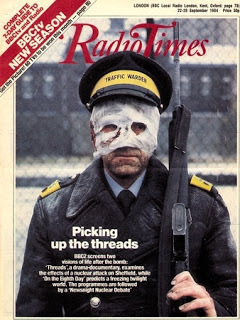 'I watched Threads for the first time a few years ago – along with a 1960s film called The War Game which seriously competes with it for the title of ‘most bleak, terrifying, doom-laden film of all time’ – and was reminded, starkly, of that childhood fear. I had to do something with that, so it went into shaping a story that was brewing in my head. At the time, it was a radio play called City Of Night. The radio play never happened, but I liked what I’d done enough to carry the story on. It became a series called The Black Road, which begins with Hell’s Ditch.
'I watched Threads for the first time a few years ago – along with a 1960s film called The War Game which seriously competes with it for the title of ‘most bleak, terrifying, doom-laden film of all time’ – and was reminded, starkly, of that childhood fear. I had to do something with that, so it went into shaping a story that was brewing in my head. At the time, it was a radio play called City Of Night. The radio play never happened, but I liked what I’d done enough to carry the story on. It became a series called The Black Road, which begins with Hell’s Ditch.'So what kind of a world is Hell’s Ditch set in?
'In it, the button has been pushed – twenty years before the book starts, Britain has been hit by a nuclear attack. It hasn’t been as bad as it could have been – for a start, some people are still alive. But the place is a mess. Millions of people have been killed in the War. Freak weather conditions have scattered radioactive fallout across the country in ‘contamination belts’.
'The country’s been split into fifteen Regional Commands (based on the contingency plans that would have prevailed had the Cold War ever turned hot) and is ruled now by a militaristic organisation called the Reapers. Much of the technology is more basic than anything we’re used to today: electronics are a rare and valuable resource as most were destroyed by electromagnetic pulse during the attack. Computers are especially rare, and have to be used sparingly, as no replacement parts are being made.
'There’s no petrol or gas, except perhaps in some parts of the Command that governs the Orkneys and Shetlands. What vehicles are available are steam-powered, running on coal or anything else that can be burnt in their boilers. The weapons used are from an older generation, from caches mothballed in the 1980s or even the 1960s, because the newer guns have worn out and broken. The society of the future is ruled with the weapons of the past: the Sterlings and L1A1 self-loading rifles the Army had during the Cold War, or Sten, Thompson and Lanchester submachine guns from World War Two.
'The Reapers are the government, the police, the security services, the army and the civil service all rolled into one. They control everything, and their primary purpose, as the only order left, is to keep themselves going. Anyone who steps out of line is met with a bullet, and anyone who doesn’t fit into their concept of a renewed Britain is disposed of – usually by the feared shock-troops of their Genetic Renewal division, otherwise known as the Jennywrens.
'There was a rebellion against the Reapers, but five years ago it was brutally smashed: its headquarters were stormed and destroyed, its forces scattered and its leaders killed – or so they thought. One of them survived. And she’s coming back, to overthrow this government.
'But there’s another kind of darkness in this book: a thread of the supernatural. Nearly everyone in this world suffers from ‘ghostlighting’: they see the dead, the people they’ve lost in the War. It could hardly be otherwise – wherever you look, you’re surrounded by reminders of what’s been destroyed and who’s been killed. Whether the ghosts are real or just inside peoples’ heads is a matter of opinion.

'Meanwhile, the Reaper Commander for North-West England – where the story is set – has one ambition: to unite Britain under his rule. To do that, he’s trying to invoke forces that should never be woken. So the stakes are higher than who rules the ruins; they’re whether anything, even ruins, will be left for anyone, anywhere, to rule.
'It’s been great to see this book finally find a home with Snowbooks, after a couple of years thinking it would never see the light of day – and that I’d never get to carry the story on. And while it’s been grim to revisit those childhood fears of mine, it’s actually pretty comforting to come up for air from the fallen world of Hell’s Ditch and remind myself that the world we live in, for all its faults and problems, isn’t in that state.
 'At least, not yet.'
'At least, not yet.'So there you go? Seriously, how does that sound? You just know you need to find out more, don't you?
Prior to this, Simon (pictured right) is the author of TIDE OF SOULS , THE FACELESS and BLACK MOUNTAIN . His short fiction has appeared in BLACK STATIC and BEST HORROR OF THE YEAR, and been collected in A HAZY SHADE OF WINTER, PICTURES OF THE DARK , LET'S DRINK TO THE DEAD and THE CONDEMNED . Just to reiterate, HELL'S DITCH , is out today, and is well, well worth checking out.
Published on December 01, 2015 02:41
November 20, 2015
Frost, snow and other terrors of the season
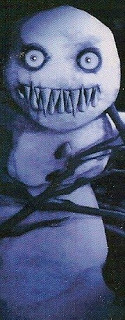 It's always difficult at this time of year not to get caught up in the whirlwind of pre-Christmas jazz (even though it's still only November, which is rapidly becoming the month that time forgot). But in truth, I can't afford not to.
It's always difficult at this time of year not to get caught up in the whirlwind of pre-Christmas jazz (even though it's still only November, which is rapidly becoming the month that time forgot). But in truth, I can't afford not to.I'm not a big fan of making your Christmas preparations early - some houses in Wigan have been sporting fairy lights and glowing Nativity figures on their roofs since as early as November 7th. Can you believe that? But I understand why the retailers have to do it. This is their main selling season, and as so often these days, it's a selling season I'm hoping to participate in myself.
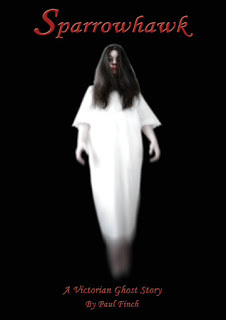 Don't worry, I'm not going to hit you with a load of advertising pap. I just want to say a few words about a piece of writing I completed in 2010, which probably still ranks as my personal favourite work, and though it's a Gothic / horror / supernatural / adventure / romance (try saying that when you've been on the festive sherry), it's also a Christmas story, possibly the most Christmassy Christmas story I've ever written -
SPARROWHAWK
.
Don't worry, I'm not going to hit you with a load of advertising pap. I just want to say a few words about a piece of writing I completed in 2010, which probably still ranks as my personal favourite work, and though it's a Gothic / horror / supernatural / adventure / romance (try saying that when you've been on the festive sherry), it's also a Christmas story, possibly the most Christmassy Christmas story I've ever written -
SPARROWHAWK
.(But before I get into all that ... at the foot of this column, you'll find my hopefully timely review of Jonathan Aycliffe's amazingly frightening supernatural novel, NAOMI’S ROOM . So if SPARROWHAWK doesn't ring your Christmas bells, that one definitely ought to).
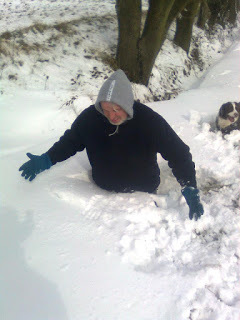 SPARROWHAWK
is a novella rather than a novel or short story - it clocks in at just over 40,000 words, and it was written over the long, white winter of 2009/2010.
SPARROWHAWK
is a novella rather than a novel or short story - it clocks in at just over 40,000 words, and it was written over the long, white winter of 2009/2010.People living up here in the North of England will remember that one, I'm sure. How on something like December 21, after days of sloppy sleet, the temperature suddenly dropped by seven degrees in one hour. How, when the snow started tumbling that night it barely stopped until well into the New Year. How our towns and cities came to resemble images from Christmas cards, or scenes from A Christmas Carol. How no cars could move, so we brought our last-minute Christmas shopping home from the supermarket on sledges.
 How on Christmas Eve itself we were able to chill all the beer for our annual party by standing it in the snow on the back terrace.
How on Christmas Eve itself we were able to chill all the beer for our annual party by standing it in the snow on the back terrace.How entire families got snowed in together, and like or loath it, ended up celebrating one big Yuletide party, which went on for days and days after the main event.
I mean, how could I not spend that most spectacular season of goodwill penning a brand new Christmas story?
Was it any surprise - certainly not to me, on reflection - that I still think it one of the best things I've ever written?
SPARROWHAWK , which is set in Dickensian London and follows the fortunes (though mainly they are misfortunes) of Captain John Sparrowhawk, an Afghan War veteran, and an embittered loner and widower, who in the year 1843 is released from the Debtors' Prison by the beautiful but enigmatic Miss Evangeline when she pays what he owes and hires him for a difficult but mysterious job - keeping watch on a London house for the duration of a very cold and snowy December.
I said earlier that SPARROWHAWK was a Gothic / horror / supernatural / adventure / romance, and I wasn't joking. It's a wide-ranging tale, emotionally and spiritually as well as geographically, and I strove strenuously for it to tick all those boxes. It's certainly not just a Victorian ghost story, as it has sometimes been described, though there are plenty of ghosts in there too.
What I tried to do with SPARROWHAWK was take a broken soul at the lowest ebb of his life and send him on a magical but eerie journey through a time of year we're all very much in love with but also wary of, because we know it has a flip-side.
While the middle-classes of Bloomsbury and Little Chelsea pull crackers, sing carols and play parlour games, the homeless of Southwark, Eastcheap and Petticoat Lane shiver under icicle-clad bridges. While the Christmas spirit pushes some to acts of great generosity, others remain unaffected, driving darkly on down their dangerous roads, oblivious to the chains they wear, their personal notion of misrule a horror to all those in their power.
 While some Christmas elves are a delight, capering and full of good cheer, others are more like goblins, lurking in the evergreens and enjoying the warmth of our homes but all the time plotting against us.
While some Christmas elves are a delight, capering and full of good cheer, others are more like goblins, lurking in the evergreens and enjoying the warmth of our homes but all the time plotting against us.I wanted to touch on all these things with SPARROWHAWK . I also wanted to give him love, or at least a taste of it - because though this is a failed husband, a reluctant father and a thoroughly undeserving specimen, all men should catch at least a glimpse of light and happiness at Christmas time. For those who enjoy my Heck novels, there's a bit of action in there too. Sparrowhawk is a warrior. He fought heroically if hopelessly in the British Empire's first great Afghan War. Now he must fight at home, in London - on the frozen back-streets, in the dank, empty warehouses, on the ice of the River Thames - against a series of foes who will challenge his sanity and his soul as well as his physical flesh.
Anyway, no more blurbing. You either like the sound of this one or you don't. But just in case you want the teeniest bit more, here are three extracts, which hint at different aspects of the Christmas of 1843 that Captain John Sparrowhawk finds himself confronted with:
All newcomers were checked on a list before being issued with a seating card and given the option of sherry or champagne, of which Sparrowhawk chose the latter and was subsequently treated to several flutes. When the assembly was complete, a bagpiper played them through an arched, whitewashed tunnel into a great, candle-lit eating hall. At one end there was a roaring fire, its mantel decked with Christmas brocade, though the bulk of the décor in the room was military, comprising countless emblems and battle standards, both home-grown and captured on the field. The dining tables were arranged around the edges of the hall, aside from the head-table, where the banquet’s host and his special guests would be seated. Down the centre, a very long table groaned beneath the weight of a festive feast. Every type of culinary luxury was on display: roast turkeys stuffed with figs and hazelnuts, saddles of pork glazed with sweet sauce, platters of salmon garnished with oysters, roast duckling, roast quail, beef and ale pies, chicken pies, mutton pies, venison pies, lamb shanks, trays of German sausage, bowls of steamed and minted vegetables. There were also cakes, puddings, tarts, plates of biscuits and great wedges of cheese filled with cranberries, apricots and other rich, spiced fruit. When General Pollock appeared, there were roars of appreciation. He was every inch the figure of legend: a great, bluff, hearty fellow, broad of shoulder, barrel of chest, and sparkling in his artilleryman’s dress-uniform of cocked hat and blue tunic with scarlet collar, gold cord loops and white belt. His hair was an immense, tawny mane, which extended onto his cheeks and top lip in the largest pair of mutton-chop whiskers Sparrowhawk had ever seen. When he greeted each guest personally, his grip was strong, almost overpowering. His large, penetrating eyes were as gold as sunburned savannah grass. Yet, when he came face-to-face with Sparrowhawk, having initially looked dismayed to see civilian garb, he broke into the warmest and toothiest of smiles.
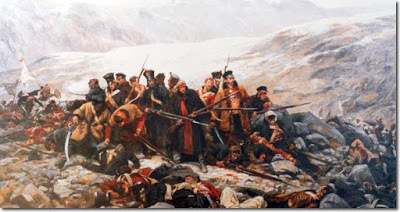 “Captain Sparrowhawk!” he boomed.
“Captain Sparrowhawk!” he boomed.
Sparrowhawk clicked his heels and bowed slightly. It didn’t feel right to make a formal salute when he was no longer in the service. “I’m honoured, my lord. And exceedingly grateful for your invitation.” “The honour is mine, captain. You’ll note from our seating arrangements that you’ve been placed alongside me at the head-table?” Sparrowhawk was astounded, and said so. “Not a bit of it, dear chap,” General Pollock replied. “There’ll always be room at my table for heroes of a genuine ilk.”
Pictured above is the horrendous last stand at Gundamuck, of which Sparrowhawk is the only survivor. Of course in a tale like this the good cheer of a Christmas military reunion is never going to last. There are many layers of life in Victorian London, and it's Sparrowhawk's fate to sample them all:
At this early hour of the day, only a handful of ruffians and painted doxies were present. Some were asleep in corners. Others were bleary eyed and brutally hungover. The landlord and his skivvies were doing what they could to clean the place up, replacing the coals in the hearth, laying fresh straw, bringing in new barrels from the storehouse at the rear. Sparrowhawk, still in his working garb and looking haggard and unshaven from his long watch, fitted in comfortably. No questions were asked when he ordered a mug of rum and a flagon of beer, and retired to the corner where he’d first located Willoughby. Only a few minutes passed before someone else sat at his table. It was one of the women. She wore a pretty bonnet with dyed-pink ostrich plumes, but this served to accentuate the drabness of the rest of her attire. Her dress was also pink, and formerly had been a mass of frills and lace, but now was faded and ragged, revealing the stained chemise beneath. Her bodice had been patched several times, but was still missing buttons. Her face, though dabbled with blusher and rouge, was extraordinarily handsome – which seemed strange given the life these impoverished creatures lived. But then Sparrowhawk smelled rose and jasmine, and he understood. “I almost didn’t recognise you,” he said. Miss Evangeline placed his letter on the table. “So you’ve resigned again?” He drank more beer. “I have.” “You realise what this means?” “I’m quite prepared for it. If you’ve been able to find me already, I expect the bailiffs will have no trouble arresting me by this afternoon.” “On what grounds can the bailiffs arrest you? Your debt has been paid.” “You said you’d bill my bail back to the court.” “A little white lie. As I told you when we first met, we didn’t make you a loan. You owe us nothing.” Sparrowhawk was puzzled. “You’re not concerned that your man will be unprotected for this final week?” “Not at all. Because he won’t be. I have no intention of allowing you to resign.”
Miss Evangeline has a touch of the 'other' about her. In the nicest possible way, of course. The same could be said for certain other individuals Sparrowhawk will encounter during this deep-frozen Christmas, except that they won't be so nice:
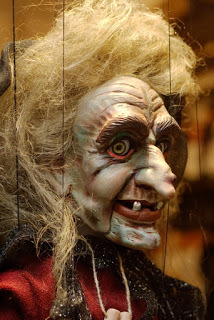 The marionette was directly behind him. Its arms were by its sides, but its head had jerked upright, the beads rolling in its bauble eyes. Its hinged jaw dropped to revel a cavernous blood-red mouth, from which a demented squawk issued - the same squawk he had heard on Doughty Street. With stiff jerks of its strings, it again raised its arms. Then it raised its left leg, and brought it down hard. It did the same with its right, and suddenly it was dancing a wild, maniacal jig; at first in front of him, then to his right, and then to his rear. With piercing squeals of laughter, it cavorted around him like a dervish. Sparrowhawk stood rigid, closing his eyes, trying to shut out the horror. But the frenzied laughter grew in volume and shrillness until it was almost ear-shatter "Enough!" he finally roared. He ripped out his sabre and, with three deft strokes, severed the dancing devil's strings. It crashed to the floor, again nothing more than a heap of lifeless disjointed wood.
The marionette was directly behind him. Its arms were by its sides, but its head had jerked upright, the beads rolling in its bauble eyes. Its hinged jaw dropped to revel a cavernous blood-red mouth, from which a demented squawk issued - the same squawk he had heard on Doughty Street. With stiff jerks of its strings, it again raised its arms. Then it raised its left leg, and brought it down hard. It did the same with its right, and suddenly it was dancing a wild, maniacal jig; at first in front of him, then to his right, and then to his rear. With piercing squeals of laughter, it cavorted around him like a dervish. Sparrowhawk stood rigid, closing his eyes, trying to shut out the horror. But the frenzied laughter grew in volume and shrillness until it was almost ear-shatter "Enough!" he finally roared. He ripped out his sabre and, with three deft strokes, severed the dancing devil's strings. It crashed to the floor, again nothing more than a heap of lifeless disjointed wood.First published in 2010 by Pendragon Press, SPARROWHAWK is now out of print unfortunately, but can still be bought as an e-novella for the non-too-princely sum of £2.41.
*
THRILLERS, CHILLERS, SHOCKERS AND KILLERS ...
An ongoing series of reviews of dark fiction (crime, thriller and horror novels) – both old and new – that I've recently read and enjoyed. I’ll endeavour to keep the SPOILERS to a minimum, but by the definition of the word ‘review’, I’m going to be talking about these books in more than just thumbnail detail, extolling the aspects that I particularly enjoyed … so I guess if you’d rather not know anything about these pieces of work in advance of reading them, then this part of the blog may not be for you. Don't say you haven't been warned.
NAOMI’S ROOM by Jonathan Aycliffe (1991)
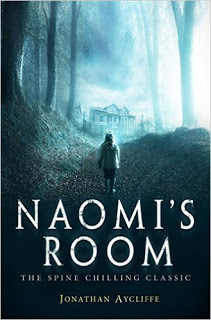 Cambridge professor, Charles Hillenbrand’s life comes to a crashing halt one snowy Christmas Eve when his four-year-old daughter, Naomi, is abducted during a shopping trip to Hamleys. When her mutilated body turns up a few days later in Spitalfields, his world ends.
Cambridge professor, Charles Hillenbrand’s life comes to a crashing halt one snowy Christmas Eve when his four-year-old daughter, Naomi, is abducted during a shopping trip to Hamleys. When her mutilated body turns up a few days later in Spitalfields, his world ends. Inconsolable, Charles and his wife, Laura, will never be the same again. They must now eke out a miserable, blame-filled existence in their once handsome townhouse, their formerly close relationship doomed, their careers on hold. But is Naomi really gone? Because the next thing they know, a haunting has commenced – initially little more than bumps in the night, though it soon escalates into far more terrifying phenomena: footsteps in the attic; strange faces peering from windows when no-one is supposed to be home; Naomi’s toys moving around apparently of their own volition. However, it is only when a troubled press photographer called Lewis presents Hillenbrand with a series of snapshots in which curious half-seen figures are visible in constant attendance on the family that it becomes apparent something more is at work here than the spirit of a happy child who doesn’t yet realise she is dead …
As a lifelong fan of supernatural fiction, I always knew that at some point I’d have to check out Jonathan Aycliffe, aka Denis MacEoin’s spine-chilling classic, Naomi’s Room, and for some inexplicable reason it’s taken me this long to do it. However, I got there in the end and I was not disappointed.
I don’t want to say much more about the plot, because basically there is a mystery to be solved here, and a very frightening one – which Hillenbrand, our tortured protagonist, must get to the bottom of (and then survive the horror of its shocking revelation!), or he’ll never find peace of mind again. Okay, that may sound familiar in a cosy ‘English ghost story’ sort of way. But it all really worked for me. The tone of Naomi’s Roomis exactly the sort I like when it comes to spooky fiction. There is something of the Gothic about it, something of M.R. James. Hip young academics though they are, the Hillenbrands still live apart from the rest of us, cosseted in the elitist, hermetically-sealed world of Cambridge academia. But as with M.R. James’s best stories, ultimately that provides no protection against the insidious threat of some decidedly malevolent spirits, whose cruel intent becomes more and more apparent the further on you read.
Unlike many stories in this traditional vein, there is quite a bit of gore in this one, while the basic premise concerns the torture and murder of children – and the author makes no effort to conceal those details from us – so it’s a bit more disturbing than the norm. But don’t let that put you off, because if you’re here to be scared, you’re in the right place. By the latter stages of this novel, the atmosphere of dread is immense, the sense of helplessness in the face of the maleficent ‘other world’ overpowering.
Even with its dollops of grue, it may still sound a tad safe and conventional to some of you. I wouldn’t totally deny that, but it’s really an excellent chiller with full potential to keep you awake at night, and so is well deserving of the fine reputation it has gained for itself over the many years of its publication.
Once again, purely as a bit of fun, here are my picks for who should play the leads if Naomi’s Room were ever to make it to the screen. I think it would make a particularly good 'ghost story for Christmas' type drama, if the Beeb ever get around to doing more of them. (I believe it is currently under option somewhere, but then what isn’t?):
Charles Hillenbrand – David TennantLaura Hillenbrand – Lenora CrichlowLewis – Rhys IfansDetective Superintendent Ruthven – Sean Harris
Published on November 20, 2015 08:35
October 22, 2015
Mystery thrillers in days of smoke and soot
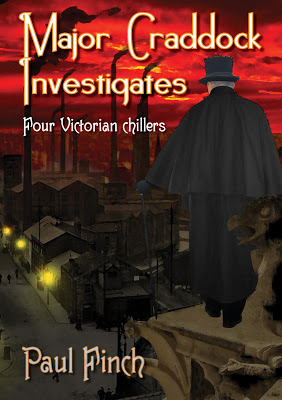 Seeing as there's been a delay on the next Heck novel, I didn't want this autumn to pass without any kind of publication from me. So I've taken the opportunity to club together a bunch of stories that are among my favourites and have now released them as an e-collection,
MAJOR CRADDOCK INVESTIGATES
, the cover to which you'll find left, superbly illustrated, as always, by Neil Williams.
Seeing as there's been a delay on the next Heck novel, I didn't want this autumn to pass without any kind of publication from me. So I've taken the opportunity to club together a bunch of stories that are among my favourites and have now released them as an e-collection,
MAJOR CRADDOCK INVESTIGATES
, the cover to which you'll find left, superbly illustrated, as always, by Neil Williams.(Before I say any more about this, just a quick note to the effect that I recently read Stav Sherez's excellent and uber-grim crime novel ELEVEN DAYS, and there's a full review of it at the bottom of this column).
My Major Craddock novellas, which I mostly penned in the late 1990s and early 2000s, are a combination of police thriller, period fantasy and gothic horror. They follow the enquiries of a Victorian-era copper, the recently widowed Major Jim Craddock, who after he leaves the British Army in India returns to his native Lancashire, now a blackened wasteland of cotton mills, coal mines, squalor and deprivation, to head up the local detective division.
There are many routine police matters to deal with - robbery, murder, rape, crimes as common in the 1860s as they are now, if not more so given the extreme poverty that so much of the population was forced to dwell in. But there are other things to deal with too, stranger things. Craddock saw much that was inexplicable during his time in the Raj, a land of magic, mystery and ancient belief. So he is better placed than most to deal with crimes back in Britain that possess apparent occult or supernatural aspects. So it's a very good thing that he's arrived when he has.
There was only one Craddock novella originally: The Magic Lantern Show, which, in his review of it, best-selling US author, Brian Hodge, said: "Finch places considerable stock in atmosphere, and builds fear and unease well with a judicious balance between what is seen, unseen and merely hinted at. A welcome new voice from across the pond."
 This was lavish praise indeed from a master of his trade like Hodge, and it helped convince me that in Craddock we had a potentially reusable character. In addition, the background of smoke, fire and soot in Britain's industrial north during the 19th century was just too interesting not to revisit.
This was lavish praise indeed from a master of his trade like Hodge, and it helped convince me that in Craddock we had a potentially reusable character. In addition, the background of smoke, fire and soot in Britain's industrial north during the 19th century was just too interesting not to revisit.The result was three more Craddock novellas, all of which are now included in MAJOR CRADDOCK INVESTIGATES .
 Aside from The Magic Lantern Show, which first appeared in The Dark Satanic in 1999, they are: Shadows In The Rafters, which was first published in By The Gas Flame Flickering in 2000, The Weeping In The Witch Hours, which first appeared in Darkness Rising in 2003 (edited by the indefatiguable Maynard & Sims), and The Coils Unseen, which is original to this collection.
Aside from The Magic Lantern Show, which first appeared in The Dark Satanic in 1999, they are: Shadows In The Rafters, which was first published in By The Gas Flame Flickering in 2000, The Weeping In The Witch Hours, which first appeared in Darkness Rising in 2003 (edited by the indefatiguable Maynard & Sims), and The Coils Unseen, which is original to this collection.They've perhaps been tidied and tightened up a little bit since their original publication, but they still reach a word-count of approximately 70,000, so they've rather neatly formed a complete book. Only one of them, The Magic Lantern Show, is set at Christmas, but I like to think they all have that 'Dickensian ghost story' feel, so they could well be a fun thing to get your hands on as we wind the year down towards the festive season.
MAJOR CRADDOCK INVESTIGATES is available for download now and HERE at a cost of £1.99. In case you still aren't convinced, here are a few excerpts from its contents:
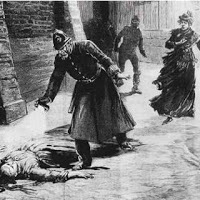 “I’m going to enjoy delivering this bastard to the Assizes,” Craddock said, gazing down on the strangled woman.
“I’m going to enjoy delivering this bastard to the Assizes,” Craddock said, gazing down on the strangled woman.The lanterns of two constables cast a wavering glow on her filthied corpse. She was sitting against a wall at a junction of two alleyways, her head hanging at a hideous angle. Her ragged dress was in disarray, her greying hair in matted locks. Once again, the neck was blackened and torn by fingers of steel. The expression on her muddied face was almost too ghastly to look at.
“Has she been used?” Munro asked of the various constables gathered there. “Has anyone looked?”Tough and granite-faced as they were, they shrugged sheepishly. It was easy to understand their dilemma. A multitude stared out and down from the surrounding windows; in all adjoining passages, dark groups of locals were being held back. It wasn’t the done thing for peelers to be caught peeping under a woman’s skirt, even if she had just been slaughtered by some demented person.“The doctor can do that when he arrives,” the major said. He knelt beside the body, his face grave. His voice lowered to a monotone. “Gentlemen – there is a monster among us. We must step very carefully from here on in ...” The Magic Lantern Show
Major Craddock and Sergeant Rafferty gazed in disbelief at the thing that hung in front of them. It had once been a human, but was now dried-out, crinkled, withered to a papery husk, as if every drop of juice had been forcibly drained. What was nore, it was bound and suspended as though on a gibbet, though no gibbet Craddock recalled had ever been set up in the depths of a railway shed. The ropes binding the skeletal thing were ancient and frayed but ran tautly up into the high, black rafters, form which it was now plain that other atrocities dangled. Rafferty held the lamp aloft in order to see better. Some of them were high, some of them low, but in every case it was the same story: withered skin, exposed bones, shreds of old clothing.
"Christ loves a Christian," the sergeant breathed. "What evil are we seeing here?"
Even in his gloves, Major Craddock reached only gingerly to touch the shrivelled face in front of them. Strands of carrot-red hair hung down over empty eye sockets. Though all the features were creased and leathery, it was easy to see that the mouth was disfigured by a gruesome harelip.
"This ... this is Fred Childs," he said. "Good God, this boy can only have been dead a few days."
Rafferty shook his head. "That's impossible!"
"Something's drunk him dry."
Shadows In The Rafters
The doctor had ordered the dead men photographed specifically because of the expressions they’d been wearing, which were truly horrible: masks of agony and fear, their mouths yawning open, their eyes clenched shut, their brows and cheeks set rigid and furrowed. Only once had Craddock seen such a thing before. In Oudh, on the sub-continent, he’d watched two criminals who’d attempted to assassinate the maharaja be staked out on the ground and then trampled by trained elephants. It had been a gruesome display indeed, but these faces very closely reminded him of it.“Whatever killed these men was ghastly,” he said, thinking aloud.“Whatever killed these men did so by acute heart failure,” Doctor Benedict replied. “Nothing more.”“You performed full post-mortems?” “Of course.”“And did either man have a physical condition that might have caused it?”“The older’s chap’s arteries were bunged up with calcium. I doubt he’d have lived too much longer in any case.”“And the younger chap?”Benedict became pensive. “More difficult. He seemed to be in the pink. But one can’t second-guess the human heart. If it stops, it stops … there’s no arguing with it.”“And what might cause it to stop?” Craddock asked. “Assuming the medical ailments were lacking.”“Shock would be the obvious thing.”“That would be physical shock? Trauma?”“Or emotional shock. But that’s rare. Extremely rare.”“But it happens?” Craddock said. “There is a possibility that someone could actually be frightened to death?”Benedict took off his spectacles. “It would have to be terror beyond imagining.”Craddock considered. That wasn’t an especially pleasant thought.The Weeping In The Witch Hours
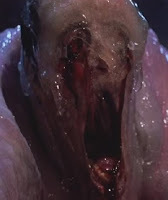 The ballast had finally fragmented, and an immense, gelatinous something was slowly writhing free of its clutches.It would have been impossible for either man, given the brief time he stood there, to offer a complete description of the abomination they now beheld. But they caught fleeting glimpses of translucent, tentacle-like protuberances oozing up through the rubble, and in the central area – where Krugg had drained his victims, and then died himself – a blob-like focal point, a quivering mound of vitreous flesh slowly forcing itself upwards, palpitating, glistening – and at the same time glowing, for it was from this very thing that the eerie, oceanic light seemed to emanate. Yet, phosphorescence wasn’t the only thing the monstrosity contained. In the very midst of it, in the thickest part, directly below the emergent point – the head, if such a thing could be called a ‘head’ – the two officers saw a human figure deeply embedded. Preposterous though it seemed, this figure appeared to be riding the creature, or at least controlling it; a demonic human agent safely encased at the globular core, issuing commands through malignant thought-impulses.Of course all this was fantasy, and unhinged fantasy at that. The enclosed figure was neither riding nor controlling anything. It wasn’t even moving – not of its own accord, for it was no longer sentient. It wasn’t just dead, it was long dead, little more than bones and carrion. Yet it struck the two officers with horror all the same, for though many of its clothes had faded and rotted away, they were still recognisable as the ragged remnants of a French naval uniform.“Holy Christ!” Munro screamed. “HOLY JESUS CHRIST!”The Coils Unseen
The ballast had finally fragmented, and an immense, gelatinous something was slowly writhing free of its clutches.It would have been impossible for either man, given the brief time he stood there, to offer a complete description of the abomination they now beheld. But they caught fleeting glimpses of translucent, tentacle-like protuberances oozing up through the rubble, and in the central area – where Krugg had drained his victims, and then died himself – a blob-like focal point, a quivering mound of vitreous flesh slowly forcing itself upwards, palpitating, glistening – and at the same time glowing, for it was from this very thing that the eerie, oceanic light seemed to emanate. Yet, phosphorescence wasn’t the only thing the monstrosity contained. In the very midst of it, in the thickest part, directly below the emergent point – the head, if such a thing could be called a ‘head’ – the two officers saw a human figure deeply embedded. Preposterous though it seemed, this figure appeared to be riding the creature, or at least controlling it; a demonic human agent safely encased at the globular core, issuing commands through malignant thought-impulses.Of course all this was fantasy, and unhinged fantasy at that. The enclosed figure was neither riding nor controlling anything. It wasn’t even moving – not of its own accord, for it was no longer sentient. It wasn’t just dead, it was long dead, little more than bones and carrion. Yet it struck the two officers with horror all the same, for though many of its clothes had faded and rotted away, they were still recognisable as the ragged remnants of a French naval uniform.“Holy Christ!” Munro screamed. “HOLY JESUS CHRIST!”The Coils Unseen*
THRILLERS, CHILLERS, SHOCKERS AND KILLERS ...
An ongoing series of reviews of dark fiction (crime, thriller and horror novels) – both old and new – that I've recently read and enjoyed. I’ll endeavour to keep the SPOILERS to a minimum, but by the definition of the word ‘review’, I’m going to be talking about these books in more than just thumbnail detail, extolling the aspects that I particularly enjoyed … so I guess if you’d rather not know anything about these pieces of work in advance of reading them, then this part of the blog may not be for you. You have been warned.
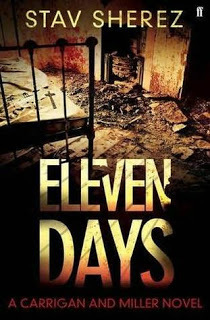 ELEVEN DAYS
by Stav Sherez (2013)
ELEVEN DAYS
by Stav Sherez (2013)When a small convent burns down in a quiet corner of West London and the ten nuns who lived there are incinerated alive, there is shock and horror – even more so when it becomes apparent the fire was started deliberately. However, this is not just a tragic case of arson. When DI Jack Carrigan and DS Geneva Miller are ordered to investigate, they quickly uncover a number of bewildering mysteries. Why did the nuns just accept their terrible fate, seemingly making no effort to escape? Why was there an unidentified 11th corpse in the ashes; as it transpires, the corpse of Emily Maxted, an angry and rebellious young woman who normally would never be seen anywhere near a church? And where is the mysterious Father McCarthy, the priest who supposedly tended to the nuns’ spiritual needs and a man with a shadowy past?
Under pressure from their superiors, in particular the narcissistic Assistant Chief Constable Quinn, to close the case quickly, preferably before Christmas – which is 11 days away – Carrigan and Miller embark on a difficult, time-pressured enquiry, which rapidly opens up into something enormous and, as it soon comes to involve South American politics, radical theology and ruthless Albanian gangsters, more perilous than anything they’ve experienced before.
If that isn’t enough, the Machievellian politics of both the Metropolitan Police and the Roman Catholic Church provide numerous distractions and in some cases near insurmountable obstacles. Lots of people have things to hide, it seems, and some have no intention of going down without taking large chunks of the world with them …
This is a labyrinthine tale, but a completely compelling one, so cleverly written by Sherez that almost every chapter either sparks a new revelation or ends on a genuine cliff-hanger. It is also a very mature novel, painted in shades of grey in that, though it does feature some of the nastiest villains I’ve come across in quite a while, there is scarcely a character in it who doesn’t have some angle, some issue, who by personal necessity is failing to follow the straight and narrow. The various political and religious activists, for example, are exceedingly well drawn – portayed largely as idealists, whose motivations are often to be lauded and yet whose zealotry has completely clouded their judgement. In an age of easy targeting, it’s a relief to see so sensitive a subject handled in such a grown-up manner.
On top of that, the whole book is played out in a near-Dickensian atmosphere of heavy snow, bitter frost and the impending Christmas season, which gives it an almost otherworldly feel (and not necessarily a pleasant one, as both our main protagonists think they are facing the festive days alone).
Carrigan and Miller make great heroes, both still vulnerable after suffering personal sadness and yet stoic and determined, and, despite differing in professional terms, dealing quite manfully with the clear if unspoken feelings they are developing for each other. They are especially challenged in this story, as they are frequently dealing with elite-level opponents to whom their police status is meaningless – which makes you cheer all the more for them as they gradually progress the investigation (though quite often, and very realistically in terms of the frustration caused, it’s often a case of one step forward and three steps back).
One of the most intriguing and suspense-laden police thrillers I’ve read in quite a while, and despite the grimness of the concept, almost poetic in the quality of its penmanship. Hugely deserving of its critical acclaim.
As usual, purely for fun you understand, here are my picks for who should play the leads if Eleven Days ever makes it to the screen (it would be the second in the series, A Dark Redemption coming first, but let’s do it anyway):
DI Jack Carrigan – Clive OwenDS Geneva Miller – Eva GreenDonna Maxted – Emma WatsonRoger Holden – Ben KinglseyACC Quinn – Tom Wilkinson Father McCarthy – Ken StottViktor – Jerome Flynn
Published on October 22, 2015 08:28
September 22, 2015
Grim tales from the darker end of the year
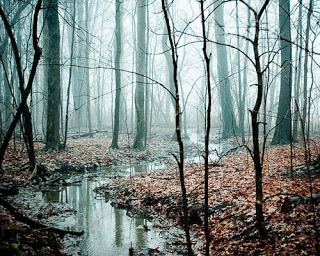 Okay ... it's THAT time of year again. Summer is finally over. The vibrant greens and yellows of the August leafage transform to red and orange. The mornings turns fresher and cooler, the nights arrive earlier and earlier - soon they are intruding into the very afternoon. Mist starts to linger on our woodland paths. And our thoughts turn slowly but surely to the darker side of the human experience ...
Okay ... it's THAT time of year again. Summer is finally over. The vibrant greens and yellows of the August leafage transform to red and orange. The mornings turns fresher and cooler, the nights arrive earlier and earlier - soon they are intruding into the very afternoon. Mist starts to linger on our woodland paths. And our thoughts turn slowly but surely to the darker side of the human experience ...It's amazing how many tellers of sinister tales have taken inspiration from the autumn months. I'm sure this harks back to those centuries-old traditions, our Norse, Saxon and Celtic ancestors having gathered the harvest and, finding themselves with nothing else to do for the next few months, crowding around the longhouse hearth, drinking ale and mead and filling each other's heads with lurid tales about the evil beings cavorting in the icy darkness outside.
The waning of the year has always exerted an eerie fascination on the minds of men. It's quite understandable given that we were once exclusively an agrarian society. In those days, the return of autumn to our land, with its cold nights, tumbling leaves and grey fogs, foreshadowing the onset of winter, during which time everything seemed to die, was in itself a terrifying prospect. In an age minus gas fires and electric lighting, when no medication was available with which to treat those innumerable cold weather ailments, just surviving the season could be a real challenge. For a superstitious people, it was easy to believe that this new harsh regime was the natural abode of goblins, ghouls and other evil spirits.
This folk memory clearly lingers in our modern tradition for autumn and winter spook stories.
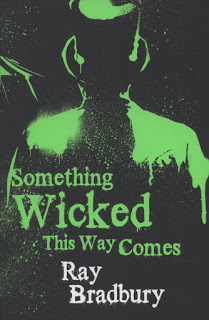 Some of the best scary fiction I've ever read has mined this exact seam. One little-known tale, Hannah of the Fields by Carey Curtis Smith, made a lasting impression on me; after I'd read it, I knew I'd never look at the Harvest Festival the same way again. Meanwhile, one of the truly best horror stories ever written, Something Wicked This Way Comes by Ray Bradbury, pits young Jim Nightshade against the 'Autumn People', who, under the guidance of the malevolent Mr. Dark, seem to encompass everything magical, mysterious and menacing about those shortening, gloomy days at the end of the year.
Some of the best scary fiction I've ever read has mined this exact seam. One little-known tale, Hannah of the Fields by Carey Curtis Smith, made a lasting impression on me; after I'd read it, I knew I'd never look at the Harvest Festival the same way again. Meanwhile, one of the truly best horror stories ever written, Something Wicked This Way Comes by Ray Bradbury, pits young Jim Nightshade against the 'Autumn People', who, under the guidance of the malevolent Mr. Dark, seem to encompass everything magical, mysterious and menacing about those shortening, gloomy days at the end of the year. At the same time, Ramsey Campbell's exquisite little suburban horror story, The Guy, perfectly captures the haunting atmosphere on November 5, when British kids, for some reason never completely understood abroad, are permitted to make effigies of human beings and gleefully burn them on bonfires (though this version of the annual event is augmented with several of Campbell's own typically grotesque innovations). Likewise, Halloween - the big daddy of all autumn festivals - has provided the backdrop to some nightmarish stories, not least another of the finest ever written, Casting The Runes by M.R. James, which was eventually adapted as an equally memorable Halloween-set movie, Night of the Demon.
At the same time, Ramsey Campbell's exquisite little suburban horror story, The Guy, perfectly captures the haunting atmosphere on November 5, when British kids, for some reason never completely understood abroad, are permitted to make effigies of human beings and gleefully burn them on bonfires (though this version of the annual event is augmented with several of Campbell's own typically grotesque innovations). Likewise, Halloween - the big daddy of all autumn festivals - has provided the backdrop to some nightmarish stories, not least another of the finest ever written, Casting The Runes by M.R. James, which was eventually adapted as an equally memorable Halloween-set movie, Night of the Demon.Of course, as these twin-subjects of Bonfire Night and Halloween testify, autumn wouldn't be autum without its special days and customs.
And yet, how many of these twisted occasions actually are there?
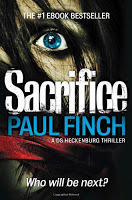 A couple of years ago, to mark the publication of my novel
SACRIFICE
, in which DS Mark Heckenburg pursues a gang of killers who are 'honouring' special days and customs with sadistic and yet very appropriate human sacrifices, I wrote a piece for this blog about the rites of spring, and how there were so many strange and uncanny traditions during March, April and May that that was by far the best time of year in which to set such a book. Consquently, it didn't come as a complete surprise to me to discover that the atumn - which gets most people's vote as the spookiest time of year - is not quite so well-endowed.
A couple of years ago, to mark the publication of my novel
SACRIFICE
, in which DS Mark Heckenburg pursues a gang of killers who are 'honouring' special days and customs with sadistic and yet very appropriate human sacrifices, I wrote a piece for this blog about the rites of spring, and how there were so many strange and uncanny traditions during March, April and May that that was by far the best time of year in which to set such a book. Consquently, it didn't come as a complete surprise to me to discover that the atumn - which gets most people's vote as the spookiest time of year - is not quite so well-endowed.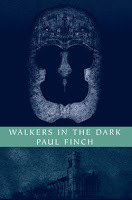 In actual fact, I'd first realised this back in 2009, when writing my novella, Season of Mist, which at this time is no longer in print, though it may still be possible to find copies of
WALKERS IN THE DARK
- the
ASH-TREE PRESS
collection in which it first appeared - available online (I do intend to put this right, by the way - hopefully there'll be an e-release sometime soon). Season of Mist concerned a bunch of school-age children in the industrial North of England, and how they became convinced that the crimes of a local serial killer were the work of a demon inadvertantly released from a derelict coalmine. It was set during the September, October and November of 1974, and my original intent was to utilise as many eerie autumn customs as I could. But ultimately, with the exception of one or two curiosties - Braughing Old Man's Day on October 2, Old Michaelmas Day (or Dog-Whipping Day!!!) on October 10, and a few modern inventions like Punkie Night, Mischief Night and Devil's Night, all in late October - I ended up falling back on the the main two occasions, which, as you'd expect, were Halloween on October 31 and Bonfire Night (or Guy Fawkes Night) on November 5.
In actual fact, I'd first realised this back in 2009, when writing my novella, Season of Mist, which at this time is no longer in print, though it may still be possible to find copies of
WALKERS IN THE DARK
- the
ASH-TREE PRESS
collection in which it first appeared - available online (I do intend to put this right, by the way - hopefully there'll be an e-release sometime soon). Season of Mist concerned a bunch of school-age children in the industrial North of England, and how they became convinced that the crimes of a local serial killer were the work of a demon inadvertantly released from a derelict coalmine. It was set during the September, October and November of 1974, and my original intent was to utilise as many eerie autumn customs as I could. But ultimately, with the exception of one or two curiosties - Braughing Old Man's Day on October 2, Old Michaelmas Day (or Dog-Whipping Day!!!) on October 10, and a few modern inventions like Punkie Night, Mischief Night and Devil's Night, all in late October - I ended up falling back on the the main two occasions, which, as you'd expect, were Halloween on October 31 and Bonfire Night (or Guy Fawkes Night) on November 5. 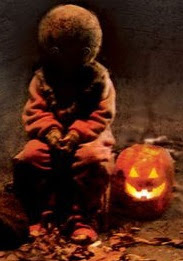 Halloween, of course, speaks for itself. Though it's a misunderstood festival, owing mainly to the Eve of Hallowtime, a medieval Christian feast on which the dead were religiously honoured, rather than a witches' sabbath, it did coincide with Samhain, an ancient Irish feast marking the end of the Harvest season and one which most likely had pre-Christian roots, so it still deserves its esoteric reputation. When the customs of these feasts are brought together - the lighting of jack-o-lanterns, the bobbing for apples, the ghoulish masquerade, the trick or treat, the telling of ghost stories - you have an event that has rightly served as an inspiration to thriller and horror writers since time immemorial, A well as those tales already mentioned, and just off the top of my head, The Samhain Feis by Peter Tremayne, The Black Pumpkin by Dean Koontz, Boo by Richard Laymon, Hollow Eyes by Guy N. Smith, The Candle In The Skull by Basil Copper, and All Souls' by Edith Wharton are all among my favourite ghost and horror stories, while Hollywood indulges itself too, seemingly every year, recent movies like Sleepy Hollow and Trick 'r' Treat going overboard in their efforts to recreate the Halloween horror experience.
Halloween, of course, speaks for itself. Though it's a misunderstood festival, owing mainly to the Eve of Hallowtime, a medieval Christian feast on which the dead were religiously honoured, rather than a witches' sabbath, it did coincide with Samhain, an ancient Irish feast marking the end of the Harvest season and one which most likely had pre-Christian roots, so it still deserves its esoteric reputation. When the customs of these feasts are brought together - the lighting of jack-o-lanterns, the bobbing for apples, the ghoulish masquerade, the trick or treat, the telling of ghost stories - you have an event that has rightly served as an inspiration to thriller and horror writers since time immemorial, A well as those tales already mentioned, and just off the top of my head, The Samhain Feis by Peter Tremayne, The Black Pumpkin by Dean Koontz, Boo by Richard Laymon, Hollow Eyes by Guy N. Smith, The Candle In The Skull by Basil Copper, and All Souls' by Edith Wharton are all among my favourite ghost and horror stories, while Hollywood indulges itself too, seemingly every year, recent movies like Sleepy Hollow and Trick 'r' Treat going overboard in their efforts to recreate the Halloween horror experience.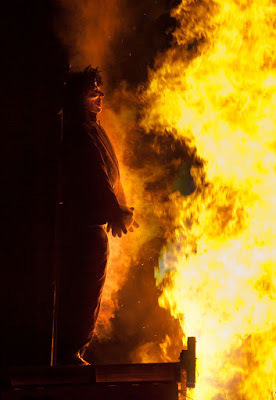 And yet, Bonfire Night, which is only really celebrated here in the UK, has more recent origins and is in several ways a much darker and crueller occasion. At one time it was illegal in England not to commemorate the capture of Guy Fawkes and the Catholic gunpowder plotters on November 5 1605 and the subsequent foiling of their plan to blow up the Houses of Parliament and murder King James I. None of those convicted were executed by burning - they were hanged, drawn and quartered instead, but the immolation of Guy Fawkes effigies all over the UK each November 5 still invokes memories of a sectarian British Isles in which religious and political differences could incur draconian punishments. That said, it's largely a fun and harmless occasion these days, sadly diminishing in my view, as health and safety regulations prohibit the impromptu lighting of bonfires outside private premises, and the use of fireworks has become quite common on special occasions all year round. However, as well as Ramsey Campbell's great tale, I can easily think of several other Bonfire Night-themed short stories: Funeral March Of A Marionette by John Metcalfe, and at least three that first appeared in the legendary Pan Horror series - Guy Fawkes Night by Richard Davis, Bonfire by C.A. Cooper, and Firework Night by St. John Bird. so clearly the spirit of the occasion still lingers in those darker imaginations.
And yet, Bonfire Night, which is only really celebrated here in the UK, has more recent origins and is in several ways a much darker and crueller occasion. At one time it was illegal in England not to commemorate the capture of Guy Fawkes and the Catholic gunpowder plotters on November 5 1605 and the subsequent foiling of their plan to blow up the Houses of Parliament and murder King James I. None of those convicted were executed by burning - they were hanged, drawn and quartered instead, but the immolation of Guy Fawkes effigies all over the UK each November 5 still invokes memories of a sectarian British Isles in which religious and political differences could incur draconian punishments. That said, it's largely a fun and harmless occasion these days, sadly diminishing in my view, as health and safety regulations prohibit the impromptu lighting of bonfires outside private premises, and the use of fireworks has become quite common on special occasions all year round. However, as well as Ramsey Campbell's great tale, I can easily think of several other Bonfire Night-themed short stories: Funeral March Of A Marionette by John Metcalfe, and at least three that first appeared in the legendary Pan Horror series - Guy Fawkes Night by Richard Davis, Bonfire by C.A. Cooper, and Firework Night by St. John Bird. so clearly the spirit of the occasion still lingers in those darker imaginations.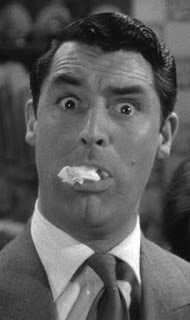 But for all these quirky traditions - wearing pumpkin heads for God's sake, burning mannequins at the stake - it's still the ambience of this time of year that does it for me. We've no sooner got used to the light and warmth of summer when suddenly it's turned cold and dark again. All at once there's a smell of fungus and mildew in the air; rich pastures become desokate wastes; trees wither before our eyes. This is surely the ideal season in which to write and set scary stories - and you don't even have to use the meaning of the special dates. Look at the iconic movie, Halloween. It's actually nothing to do with the festival of All Hallows Eve - it's a tale of a mass murder which just happens to be set on October 31, and yet it works so well. Hey, it doesn't even have to be genuinely scary. Check out that comedy/horror masterpiece of stage and screen, Arsensic and Old Lace. I swear, you'll be screaming with laughter, not terror, but it's another Halloween classic all the same.
But for all these quirky traditions - wearing pumpkin heads for God's sake, burning mannequins at the stake - it's still the ambience of this time of year that does it for me. We've no sooner got used to the light and warmth of summer when suddenly it's turned cold and dark again. All at once there's a smell of fungus and mildew in the air; rich pastures become desokate wastes; trees wither before our eyes. This is surely the ideal season in which to write and set scary stories - and you don't even have to use the meaning of the special dates. Look at the iconic movie, Halloween. It's actually nothing to do with the festival of All Hallows Eve - it's a tale of a mass murder which just happens to be set on October 31, and yet it works so well. Hey, it doesn't even have to be genuinely scary. Check out that comedy/horror masterpiece of stage and screen, Arsensic and Old Lace. I swear, you'll be screaming with laughter, not terror, but it's another Halloween classic all the same.So go on, take the darkening of the year on the chin. Immerse yourself in its dreariness and gloom, and in the eeriness and downright weirdness of its customs, and let it carry you away on a tide of imaginary menace. And get bloody writing.
*
THRILLERS, CHILLERS, SHOCKERS AND KILLERS ...
A new and ongoing series of reviews of dark fiction (crime, thriller and horror novels) – both old and new – that I've recently read and enjoyed. I’ll endeavour to keep the SPOILERS to a minimum, but by the definition of the word ‘review’, I’m going to be talking about these books in more than just thumbnail detail, extolling the aspects that I particularly enjoyed … so I guess if you’d rather not know anything about these pieces of work in advance of reading them, then this part of the blog may not be for you. You have been warned.
 THE TERROR
by Dan Simmons (2007)
THE TERROR
by Dan Simmons (2007)In 1845, the Franklin Expedition set sail from England to forge the Northwest Passage through the Canadian Arctic. It wasn’t the first expedition to attempt this, and it wouldn’t be the last. But few better equipped vessels under the control of more reliable and experienced crews would ever undertake the task. It is all the more baffling then that the Franklin Expedition wasn’t just a failure but a catastrophe. Both ships, HMS Erebusand HMS Terror, vanished without trace – it was 2014 before the remnants of one of the vessels, the Erebus, were found underwater in Baffin Bay, and though a few pathetic graves were also discovered onshore, the majority of the 200-strong crew were never accounted for.
What actually happened will never be known, but in his blockbusting horror opus, The Terror, US author Dan Simmons gives us his own unique version of events – and it is one of the most enthralling and chilling stories you are ever likely to read.
As if the ravages of hypothermia, frostbite, scurvy and lead poisoning aren’t enough, the ships’ crews, who are already icebound when we join them, must also deal with a ferocious and unstoppable monster drawn straight from the darkest corner of Inuit mythology and now intent upon hunting them to the last man …
But, whatever you do, don’t come at this book under the impression that it’s simply a creature feature. Yes, the monster is relentless and terrifying and one of the main characters in the book – and its attacks are truly horrific, but there is so much more to The Terror than this.
To begin with, Simmons gives us a detail-crammed account of a hugely complex and heroic undertaking, leaving nothing out as he constructs in our mind’s eye the image of an invincible force, the best the Royal Navy’s Discovery Service can offer – the cream of its officers, the pick of its men, and the finest two ships in the fleet, both driven by new-fangled steam engines and ploughing the ice with their armour plated hulls – and then, slowly and sadistically deconstructs it, hitting us blow by blow with its gradual deteoriation in the White Hell of the Arctic wilderness, one thing after another going wrong from the mundane to the unbelievably disastrous … until all that remains is annihilation. Even without the monster, this would be an orgy of hardship, the participants constantly called on to use every scrap of strength and ingenuity they have just to survive for one day more, and so often failing.
It’s an epic of endurance, a saga of suffering. And as such, the book is massive – its prodigious length (an amazing 944 pages!) has supposedly put some punters off. But it’s so well-written and so readable that – for all its colossal length there is scarely no padding, and despite the fact so much of it is spent on the desolate ice-floes or deep in the nauseating dungeons below decks – its pace just bounces along.
And as I say, it’s more than just a litany of horrors. Before its huge cast of characters gets whittled down, Dan Simmons creates a vivid cross-section of 19thcentury sea-faring life, from tough, professional seamen to damned rankers, from captains courageous to traitors and mutineers. The life-and-death intricacies of Arctic navigation are also laid out in minute and fascinating detail. It’s a wonder of research. You’d almost believe Simmons had been there himself and experienced it.
And then we have the set-pieces, which are among the best and most savage I’ve ever read. The battles with the ice-beast, the brutal flogging of the seditious, the cannibalisation of slain comrades, and most startling of all, a grand and crazy masquerade on the ice – men driven mad by cold and starvation cavorting in lurid costmes, performing profane rituals from the world of Grand Guignol in temperatures of a hundred below …
I can’t say anymore, except that The Terror is a historical horror masterpiece and must be read to be believed. Whatever you do, don’t let its size put you off. This is a page-turner of the first order.
And now, as usual just for fun, a bit of fantasy casting. My picks for who should play the leads if The Terror were ever to make it to the screen (my latest understanding is that a TV series is in development – probably not enough masked superheroes for it to get the big screen treatment):
Captain Francis Crozier – Michael FassbenderDoctor Harry Goodsir – Timothy SpallLieutenant John Irving – Eddie RedmayneCornelius Hickey – Andy SerkisThomas Blanky – Robson GreenLady Silence – Roseanne SupernaultSir John Franklin – Anthony Hopkins
(This week's pictures, are, from the top down: Autumn Woods by 221 Bbakerbabe; the original cover for Something Wicked This Way Comes, Niall McGuinness in Night of the Demon; Sacrifice; Walkers In The Dark; a still from Trick 'r' Treat Bonfire Night at Billiecray by William Warby, Cary Grant in Arsenic And Old Lace, and The Terror.
Published on September 22, 2015 01:42



